Please use a modern browser to view this website. Some elements might not work as expected when using Internet Explorer.
- Landing Page
- Luxury Yacht Vacation Types
- Corporate Yacht Charter
- Tailor Made Vacations
- Luxury Exploration Vacations
- View All 3617
- Motor Yachts
- Sailing Yachts
- Classic Yachts
- Catamaran Yachts
- Filter By Destination
- More Filters
- Latest Reviews
- Charter Special Offers
- Destination Guides
- Inspiration & Features
- Mediterranean Charter Yachts
- France Charter Yachts
- Italy Charter Yachts
- Croatia Charter Yachts
- Greece Charter Yachts
- Turkey Charter Yachts
- Bahamas Charter Yachts
- Caribbean Charter Yachts
- Australia Charter Yachts
- Thailand Charter Yachts
- Dubai Charter Yachts
- Destination News
- New To Fleet
- Charter Fleet Updates
- Special Offers
- Industry News
- Yacht Shows
- Corporate Charter
- Finding a Yacht Broker
- Charter Preferences
- Questions & Answers
- Add my yacht
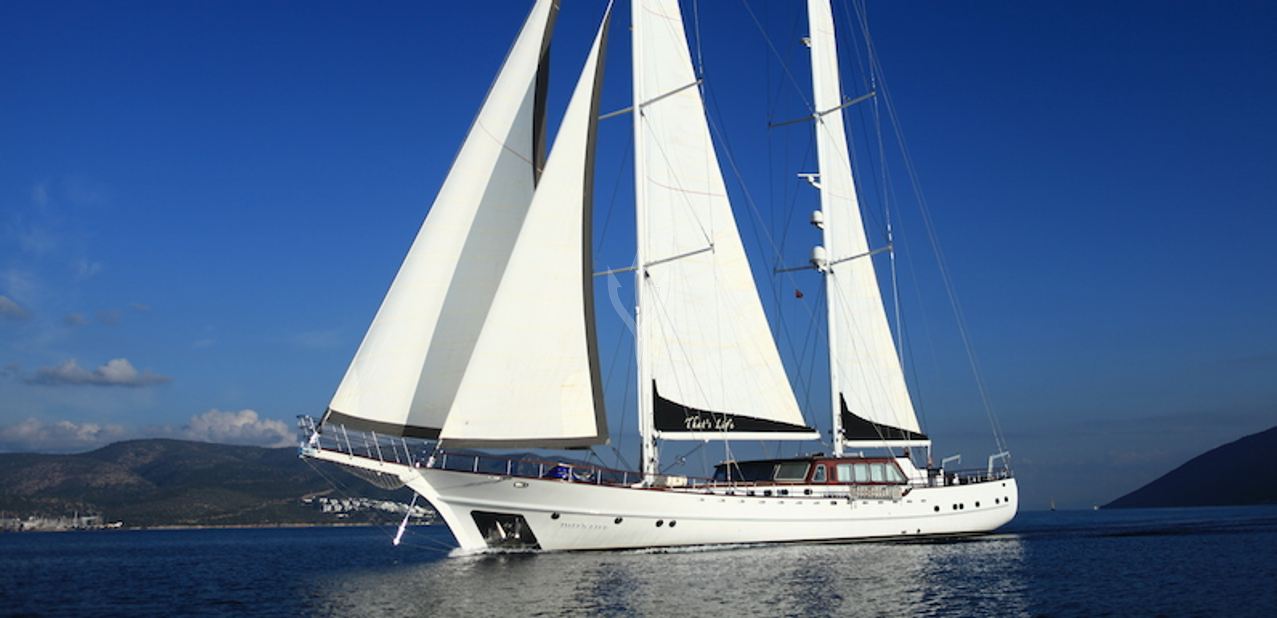
Private YACHT
NOT FOR CHARTER*
SIMILAR YACHTS FOR CHARTER
VIEW SIMILAR YACHTS
Or View All luxury yachts for charter
- Luxury Charter Yachts
- Yachts for Charter
That's Life
- Amenities & Toys

THAT'S LIFE yacht NOT for charter*
38.74m / 127'1 | custom | 2009.
Owner & Guests
Cabin Configuration
- Previous Yacht
Special Features:
- ABS (American Bureau of Shipping) classification
- Sleeps 10 overnight
- Shallow draft and fast speeds for reef exploration
The 38.74m/127'1" gulet yacht 'That's Life' was built by Custom .
Guest Accommodation
That's Life has been designed to comfortably accommodate up to 10 guests in 5 suites comprising one VIP cabin. She is also capable of carrying up to 7 crew onboard to ensure a relaxed luxury yacht experience.
Onboard Comfort & Entertainment
Her features include WiFi and air conditioning.
Range & Performance
That's Life is built with a mahogany hull and mahogany superstructure, with teak decks. That's Life comfortably cruises at 10 knots, reaches a maximum speed of 13 knots. Her low draft of makes her primed for accessing shallow areas and cruising close to the shorelines. She was built to ABS (American Bureau of Shipping) classification society rules.
PRIVATE YACHT - "That's Life" IS NOT FOR CHARTER
Sorry, motor yacht "That's Life" is a strictly Private yacht and is NOT available for Charter. Click here to view similar yachts for charter , or contact your Yacht Charter Broker for information about renting another luxury charter yacht.
"Yacht Charter Fleet" is a free information service, if your vessel changes its status, and does become available for charter, please contact us with details and photos and we will update our records.
That's Life Photos
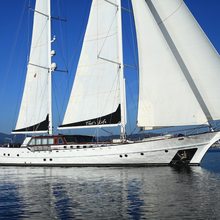
NOTE to U.S. Customs & Border Protection
NOTE TO U.S. CUSTOMS & BORDER PROTECTION
Due to the international and fluid nature of the yachting business and the fact there is no global central industry listing service to which all charter yachts subscribe it is impossible to ascertain a truly up-to-date view of the market. We are a news and information service and not always informed when yachts leave the charter market, or when they are recently sold and renamed it is not clear if they are still for charter. Whilst we use our best endeavors to maintain accurate information, the existence of a listing on this website should in no way supersede official documentation supplied by representatives of a yacht.
Specification
M/S That's Life
SIMILAR LUXURY YACHTS FOR CHARTER
Here are a selection of superyachts which are similar to That's Life yacht which are believed to be available for charter. To view all similar luxury charter yachts click on the button below.

40m | Ruth Yachting
from $59,000 p/week ♦︎
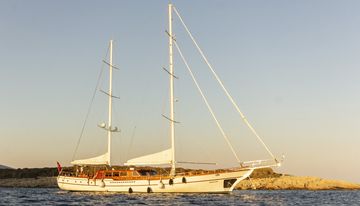
36m | Leymar
from $27,000 p/week ♦︎

35m | Blue Sea Maritime
from $46,000 p/week ♦︎
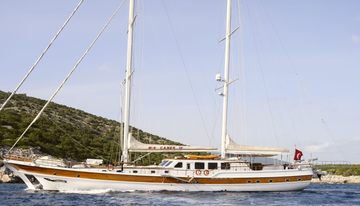
36m | Custom
from $29,000 p/week ♦︎
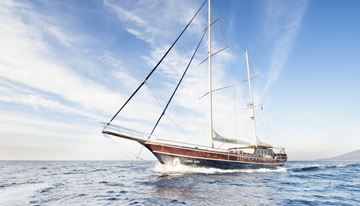
39m | Cobra Yacht
from $23,000 p/week ♦︎
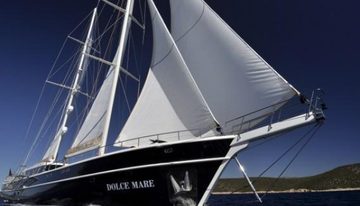
36m | Neta Marine
from $35,000 p/week ♦︎

Double Eagle
40m | Fethiye Shipyard
from $33,000 p/week ♦︎
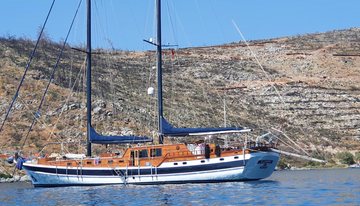
39m | Custom
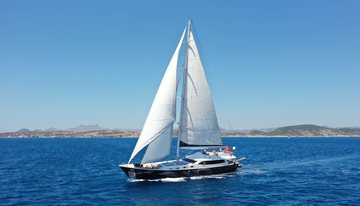
37m | Bodrum Shipyard
from $34,000 p/week ♦︎
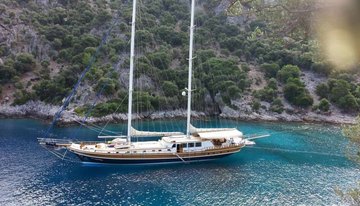
Kaya Guneri IV
35m | Bodrum Shipyard
from $17,000 p/week ♦︎
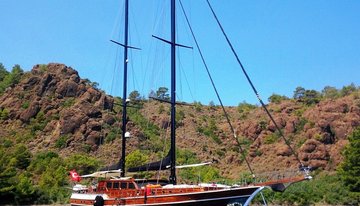
Kaya Guneri Plus
from $15,000 p/week ♦︎
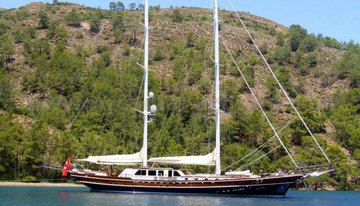
Kaya Guneri V
40m | Bodrum Shipyard
from $28,000 p/week ♦︎
As Featured In
The YachtCharterFleet Difference
YachtCharterFleet makes it easy to find the yacht charter vacation that is right for you. We combine thousands of yacht listings with local destination information, sample itineraries and experiences to deliver the world's most comprehensive yacht charter website.
San Francisco
- Like us on Facebook
- Follow us on Twitter
- Follow us on Instagram
- Find us on LinkedIn
- Add My Yacht
- Affiliates & Partners
Popular Destinations & Events
- St Tropez Yacht Charter
- Monaco Yacht Charter
- St Barts Yacht Charter
- Greece Yacht Charter
- Mykonos Yacht Charter
- Caribbean Yacht Charter
Featured Charter Yachts
- Maltese Falcon Yacht Charter
- Wheels Yacht Charter
- Victorious Yacht Charter
- Andrea Yacht Charter
- Titania Yacht Charter
- Ahpo Yacht Charter
Receive our latest offers, trends and stories direct to your inbox.
Please enter a valid e-mail.
Thanks for subscribing.
Search for Yachts, Destinations, Events, News... everything related to Luxury Yachts for Charter.
Yachts in your shortlist

Who Owns Which Superyacht? (A Complete Guide)
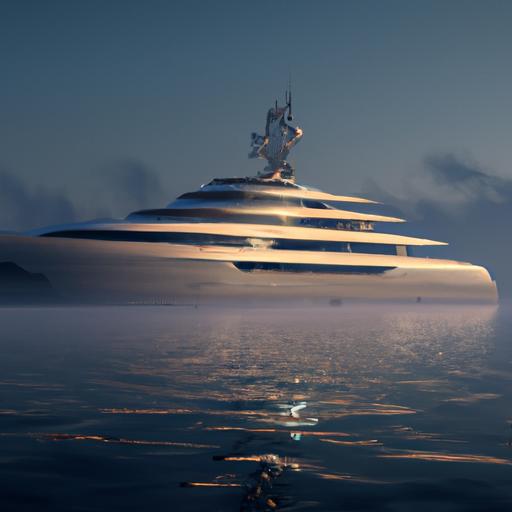
Have you ever wondered who owns the most luxurious, extravagant, and expensive superyachts? Or how much these lavish vessels are worth? In this complete guide, we’ll explore who owns these magnificent vessels, what amenities they hold, and the cost of these incredible yachts.
We’ll also take a look at some of the most expensive superyachts in the world and the notable people behind them.
Get ready to explore the world of superyachts and the people who own them!
Table of Contents
Short Answer
The ownership of superyachts is generally private, so the exact answer to who owns which superyacht is not always publicly available.
However, there are some notable superyacht owners that are known.
For example, Larry Ellison, the co-founder of Oracle, owns the Rising Sun, which is the 11th largest superyacht in the world.
Other notable owners include Russian billionaire Roman Abramovich and Microsoft co-founder Paul Allen.
Overview of Superyachts
The term superyacht refers to a large, expensive recreational boat that is typically owned by the worlds wealthy elite.
These vessels are designed for luxury cruising and typically range in size from 24 meters to over 150 meters, with some even larger.
Superyachts usually feature extensive amenities and creature comforts, such as swimming pools, outdoor bars, movie theaters, helipads, and spas.
Superyachts can range in price from $30 million to an astonishingly high $400 million.
Like most luxury items, the ownership of a superyacht is a status symbol for those who can afford it.
The list of superyacht owners reads like a whos who of billionaires, with names like Russian billionaire Roman Abramovich, Microsoft co-founder Paul Allen, and Amazon founder Jeff Bezos.
The most expensive superyacht in the world is owned by the Emir of Qatar, Sheikh Tamim bin Hamad Al Thani.
While some superyacht owners prefer to keep their vessels out of the public eye, others have made headlines with their extravagant amenities.
Some of the most famous superyachts feature swimming pools, private beaches, helicopter pads, on-board cinemas, and luxurious spas.
In conclusion, owning a superyacht is an exclusive status symbol for the world’s wealthy elite.
These vessels come with hefty price tags that can range from $30 million to over $400 million, and feature some of the most luxurious amenities imaginable.
Notable owners include the Emir of Qatar, Russian billionaire Roman Abramovich, Microsoft co-founder Paul Allen, and Amazon founder Jeff Bezos.
Who are the Owners of Superyachts?

From Hollywood celebrities to tech billionaires, superyacht owners come from all walks of life.
Many of the most well-known owners are billionaires, including Russian billionaire Roman Abramovich, Microsoft co-founder Paul Allen, and Amazon founder Jeff Bezos.
Other notable owners include Hollywood stars such as Leonardo DiCaprio and Johnny Depp.
However, not all superyacht owners are wealthy.
Many are everyday people who have worked hard and saved up to purchase their dream vessel.
Other notable billionaire owners include Oracle co-founder Larry Ellison, Saudi Prince Alwaleed bin Talal, and former US President Donald Trump.
These luxurious vessels come with hefty price tags that can range from $30 million to over $400 million.
For many superyacht owners, their vessels serve as a status symbol of wealth and luxury.
Some owners prefer to keep their yachts out of the public eye, while others have made headlines with their extensive amenities – from swimming pools and helicopter pads to on-board cinemas and spas.
Many of these yachts are designed to the owner’s exact specifications, ensuring that each one is totally unique and reflects the owner’s individual tastes and personality.
Owning a superyacht is an exclusive club, reserved for those with the means and the desire to experience the ultimate in luxury.
Whether they are billionaires or everyday people, superyacht owners are all united in their love of the sea and their appreciation for the finer things in life.
The Most Expensive Superyacht in the World
When it comes to superyachts, Sheikh Tamim bin Hamad Al Thani, the Emir of Qatar, certainly knows how to make a statement.
His luxury vessel, the 463-foot Al Mirqab, holds the title of the world’s most expensive superyacht.
Built in 2008 by German shipbuilder Peters Werft, this impressive yacht is complete with 10 luxurious cabins, a conference room, cinema, and all the amenities one would expect from a vessel of this magnitude.
In addition, the Al Mirqab features a helipad, swimming pool, and even an outdoor Jacuzzi.
With a price tag of over $400 million, the Al Mirqab is one of the most expensive yachts in the world.
In addition to the Emir of Qatar, there are several other notable owners of superyachts.
Russian billionaire Roman Abramovich, Microsoft co-founder Paul Allen, and Amazon founder Jeff Bezos all own luxurious vessels.
Bezos yacht, the aptly named The Flying Fox, is one of the longest superyachts in the world at a staggering 414 feet in length.
The Flying Fox also comes with a host of amenities, such as a helipad, swimming pool, spa, and multiple outdoor entertaining areas.
Bezos also reportedly spent over $400 million on the vessel.
Other notable owners of superyachts include Saudi Prince Alwaleed bin Talal, who owns the $200 million Kingdom 5KR, and Oracle founder Larry Ellison, who owns the $200 million Rising Sun.
There are also many lesser-known owners, such as hedge-fund manager Ken Griffin, who owns the $150 million Aviva, and investor Sir Philip Green, who owns the $100 million Lionheart.
No matter who owns them, superyachts are sure to turn heads.
With their impressive size, luxurious amenities, and hefty price tags, these vessels have become a symbol of wealth and prestige.
Whether its the Emir of Qatar or a lesser-known owner, the worlds superyacht owners are sure to make a statement.
Notable Superyacht Owners

When it comes to the wealthiest and most luxurious owners of superyachts, the list reads like a whos who of the worlds billionaires.
At the top of the list is the Emir of Qatar, Sheikh Tamim bin Hamad Al Thani, who holds the distinction of owning the most expensive superyacht in the world.
Aside from the Emir, other notable owners include Russian billionaire Roman Abramovich, Microsoft co-founder Paul Allen, and Amazon founder Jeff Bezos.
All of these owners have made headlines with their extravagant vessels, which are typically priced between $30 million and $400 million.
The amenities that come with these vessels vary greatly from owner to owner, but they almost always include luxurious swimming pools, helicopter pads, on-board cinemas, and spas.
Some owners opt for more extravagant features, such as submarines, personal submarines, and even their own personal submarines! Other owners prefer to keep their vessels out of the public eye, but for those who prefer a more showy approach, they can certainly make a statement with a superyacht.
No matter who owns the vessel, it’s no surprise that these superyachts are a status symbol among the world’s wealthiest.
Whether you’re trying to impress your peers or just looking to enjoy a luxurious outing, owning a superyacht is the ultimate way to show off your wealth.
What Amenities are Included on Superyachts?
Owning a superyacht is a sign of wealth and prestige, and many of the worlds most prominent billionaires have their own vessels.
The most expensive superyacht in the world is owned by the Emir of Qatar, Sheikh Tamim bin Hamad Al Thani, while other notable owners include Russian billionaire Roman Abramovich, Microsoft co-founder Paul Allen, and Amazon founder Jeff Bezos.
The cost of a superyacht can range from $30 million to over $400 million, but the price tag doesnt quite capture the sheer extravagance and amenities of these vessels.
Superyachts come with all the comforts of home, and then some.
Many owners will equip their vessels with swimming pools, helicopter pads, on-board cinemas, spas, and other luxury amenities.
The interior of a superyacht can be custom-designed to the owners specifications.
Some owners opt for modern, sleek designs, while others prefer a more traditional look.
Many of the most luxurious yachts feature marble floors, walk-in closets, and custom-made furniture.
Some vessels even come with a full-service gym, complete with exercise equipment and trained professionals.
Other amenities may include a library, casino, media room, and private bar.
When it comes to outdoor amenities, superyachts have some of the most impressive features in the world.
Many yachts come with outdoor entertainment areas, complete with full kitchens, dining rooms, and lounge areas.
Some owners even opt for hot tubs or jacuzzis for relaxing afternoons in the sun.
And, of course, there are the jet skis, water slides, and other exciting water activities that come with many of these vessels.
No matter what amenities a superyacht has, it is sure to be an experience like no other.
From the sleek interiors to the luxurious outdoor features, these vessels provide a unique, luxurious experience that is unrivaled on land.
Whether you’re looking for a relaxing escape or an exciting adventure, a superyacht is sure to provide.
How Much Do Superyachts Cost?

When it comes to superyachts, the sky is the limit when it comes to cost.
These luxury vessels come with hefty price tags that can range from anywhere between $30 million to over $400 million.
So, if youre in the market for a superyacht, youre looking at an investment that could easily break the bank.
The cost of a superyacht is driven by a variety of factors, including size, amenities, and customization.
Generally, the larger the yacht, the more expensive it will be.
Superyachts typically range in size from 100 feet to over 200 feet, and they can be as wide as 40 feet.
The bigger the yacht, the more luxurious features and amenities it will have.
Amenities also play a significant role in the cost of a superyacht.
While some owners prefer to keep their yachts out of the public eye, others have made headlines with their extensive amenities.
From swimming pools and helicopter pads to on-board cinemas and spas, the sky is the limit when it comes to customizing a superyacht.
The more amenities a superyacht has, the more expensive it will be.
Finally, customization is another major factor that will drive up the cost of a superyacht.
Many luxury vessels have custom-designed interiors that are tailored to the owners tastes.
From custom furniture and artwork to lighting and audio systems, the cost of a superyacht can quickly escalate depending on the level of customization.
In short, the cost of a superyacht can vary widely depending on its size, amenities, and customization.
While some may be able to get away with spending a few million dollars, others may end up spending hundreds of millions of dollars on their dream yacht.
No matter what your budget is, its important to do your research and find out exactly what youre getting for your money before signing on the dotted line.
Keeping Superyachts Out of the Public Eye
When it comes to owning a superyacht, some owners prefer to keep their vessels out of the public eye.
Understandably, these individuals are concerned with privacy and discretion, and therefore tend to take measures to ensure their yachts are not visible to outsiders.
For instance, some superyacht owners opt to keep their vessels in private marinas, away from the public areas of larger ports.
Additionally, some yacht owners may choose to hire security guards to patrol and protect their vessels while they are moored or sailing.
In addition to physical security, some superyacht owners also use technology to keep their vessels out of the public eye.
For example, a yacht owner may choose to install a satellite-based communications system that allows them to keep their vessel completely off-radar.
This system works by bouncing signals off satellites rather than transmitting them, making it virtually impossible for anyone to track the yachts movements.
Finally, some superyacht owners also choose to limit the number of people who have access to their vessels.
For instance, the owner may only allow family members and close friends to board the yacht.
Additionally, the owner may choose to employ a limited number of staff to help maintain the vessel and keep it running smoothly.
These individuals may be required to sign non-disclosure agreements to ensure they do not disclose any information about the yacht or its owner.
Overall, while some superyacht owners may choose to keep their vessels out of the public eye, there are still plenty of other ways to show off the opulence associated with owning a superyacht.
From swimming pools and helicopter pads to on-board cinemas and spas, there are many luxurious amenities that can make a superyacht the envy of any jet setter.
Final Thoughts
Superyachts are a symbol of luxury and status, and the list of yacht owners reads like a who’s who of billionaires.
From the Emir of Qatar’s world-record breaking $400 million yacht to Microsoft co-founder Paul Allen’s vessel with a helicopter pad and on-board spa, the amenities of these luxury vessels are truly stunning.
With prices ranging from $30 million to over $400 million, owning a superyacht is an expensive endeavor.
Whether you’re looking to purchase one or just curious to learn more about the owners and their amenities, this guide will provide you with all the information you need to stay up to date with the superyacht scene.
James Frami
At the age of 15, he and four other friends from his neighborhood constructed their first boat. He has been sailing for almost 30 years and has a wealth of knowledge that he wants to share with others.
Recent Posts
When Was Banana Boat Song Released? (HISTORICAL INSIGHTS)
The "Banana Boat Song" was released in 1956 by Harry Belafonte. This calypso-style song, also known as "Day-O," became a huge hit and remains popular to this day for its catchy tune and upbeat...
How to Make Banana Boat Smoothie King? (DELICIOUS RECIPE REVEALED)
To make a Banana Boat Smoothie King smoothie at home, start by gathering the ingredients: a ripe banana, peanut butter, chocolate protein powder, almond milk, and ice. Blend the banana, a scoop of...
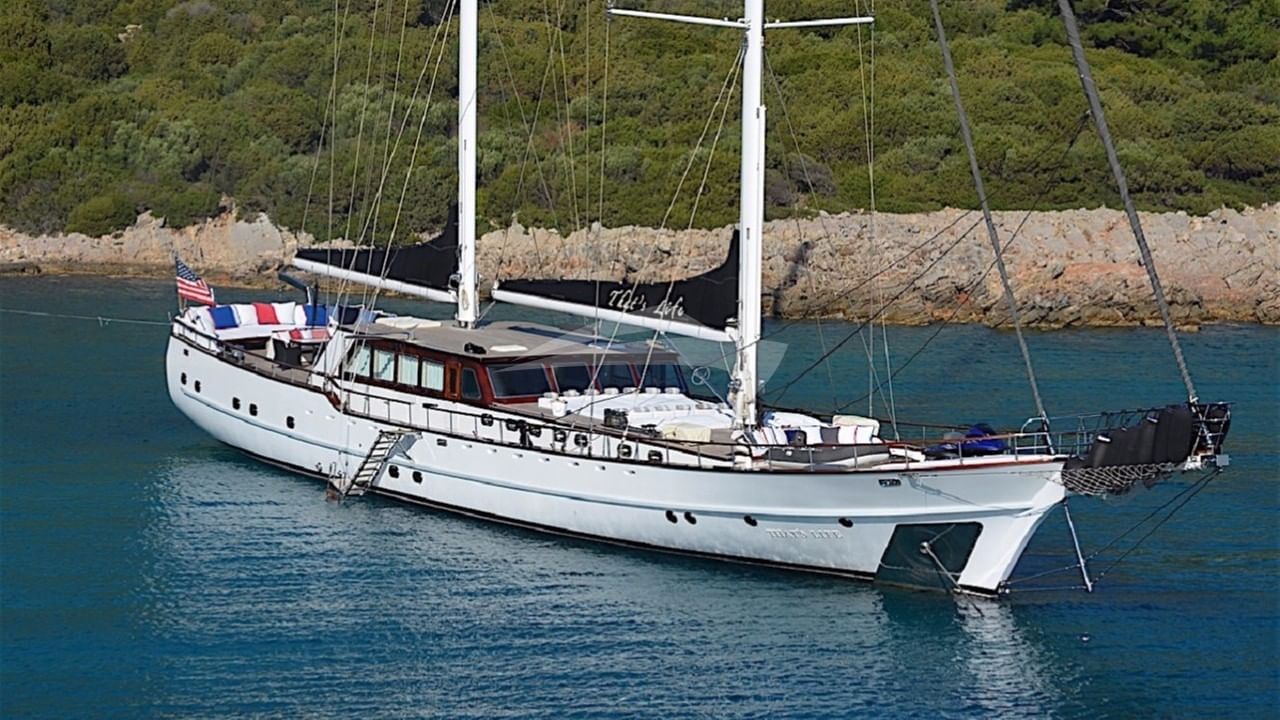
THAT'S LIFE
2009 custom 127ft / 38.7m.
Unavailable
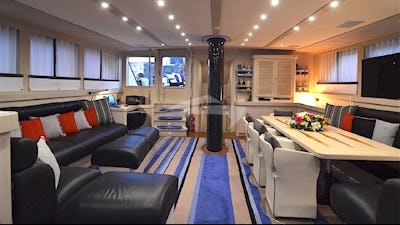
THAT'S LIFE private yacht
The luxury sailing yacht THAT'S LIFE is a private yacht and is not available to charter.
THAT'S LIFE was built by Custom and delivered to her owner in 2009.
THAT'S LIFE can accommodate 10 guests in 5 cabins consisting of a primary suite with a king size bed and en-suite bathroom facilities, 2 cabins with a king size bed and en-suite bathroom facilities, a cabin with a single bed and a pullman bed and en-suite bathroom facilities and a cabin with a twin bed and en-suite bathroom facilities.
Amenities on board include Air Conditioning, Outdoor shower, Light fishing gear, Games console, Indoor audio system, Outdoor audio system, Satellite TV, TV all cabins, TV saloon and Wi-Fi.
An extensive list of further amenities and water toys can be seen under the features and amenities section.
You can view alternative similar sailing yachts for charter , or alternatively contact your Yacht Charter Broker for information about renting an alternative luxury charter yacht.
- Air Conditioning
- Outdoor shower
- Light fishing gear
- Games console
- Indoor audio system
- Outdoor audio system
- Satellite TV
- TV all cabins
- Jet Ski (standup)
- Paddleboard
- Water skis - adult
- Snorkeling Gear
- Zodiac 115hp
Destinations

Frequently Asked Questions
How many guests on board that's life.
THAT'S LIFE can accommodate 10 sleeping guests on board in 5 cabins.
Legal Disclaimer
Sailing Yacht THAT'S LIFE is displayed on this page for informational purposes and may not necessarily be available for charter. The yacht details are displayed in good faith and whilst believed to be correct are not guaranteed, please check with your charter broker. Charter Index does not warrant or assume any legal liability or responsibility for the accuracy, completeness, or usefulness of any information or images displayed as they may not be current. All yacht details and charter pricing are subject to change without prior notice and are without warranty.
U.S. Customs & Border Protection
The yachting industry has no global listing service to which all charter yachts must subscribe to, making it impossible to ascertain a truly up-to-date view of the market. Charter Index is a news and information service and not always informed when yachts leave the charter market, or when they are recently sold and renamed, it is not always clear if they are still for charter. Whilst we endeavour to maintain accurate information, the existence of a listing on Charter Index should in no way supersede official documentation supplied by the representatives of a yacht.
Specification
Popular related yachts, east mediterranean.
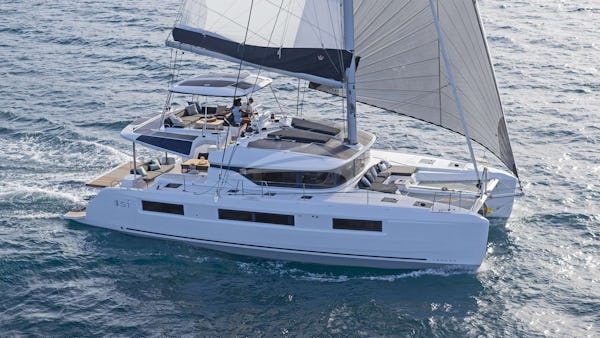
West Mediterranean
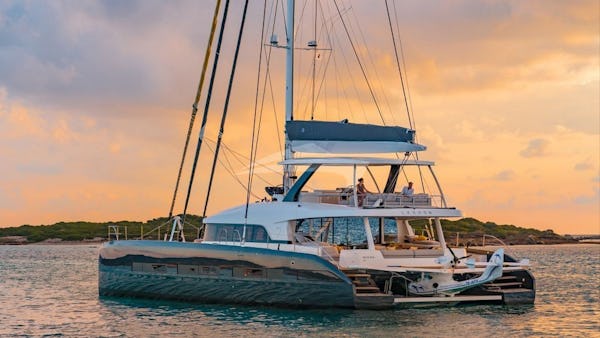
Who Owns Superyachts In 2023 —And What Does That Mean For You As Crew?
Where once oligarchs, oil tycoons, royals and old money ruled the roost in the yachting world, tech billionaires have increasingly dominated the superyacht market. Who are these people — and more importantly — what does their different style of ‘yachting’ mean for you as crew?
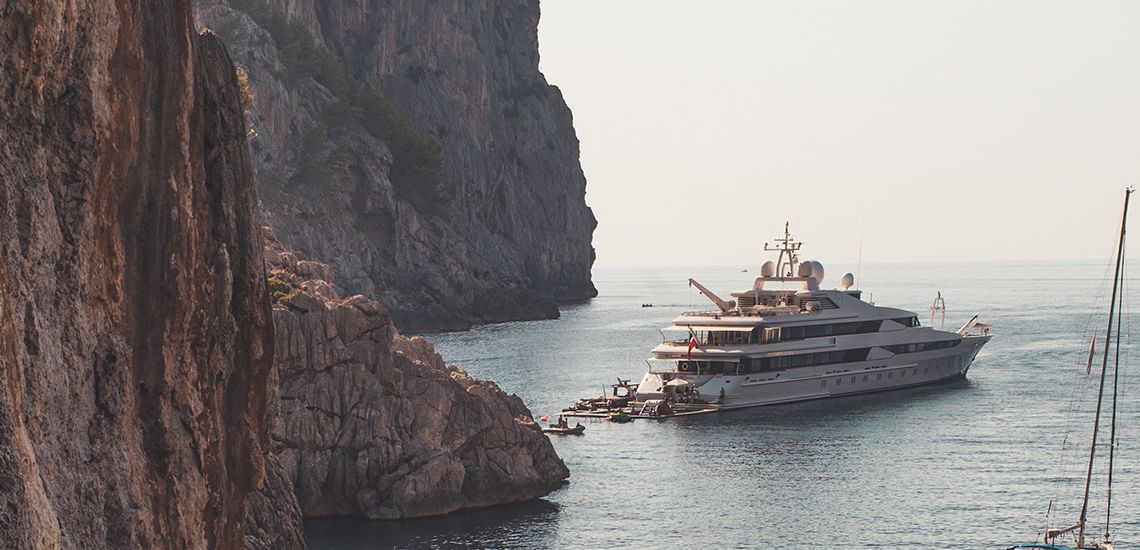
The list of tech billionaires (at least, the list we know of) is long and getting longer by the year. And as their wealth grows, so does the size of the boats they own!
Jeff Bezos, Larry Ellison (Musashi), Charles Simonyi (SKAT), Sergey Brin (Dragonfly), and Larry Page (Senses) are just some of the tech billionaires known to own a superyacht. Mark Zuckerberg, meanwhile, is rumoured to own Andromeda.
While we can only speculate on how these exact individuals use their yachts or what they are like onboard, some general traits might set the tech billionaire yacht owner out as using their yachts differently than generations of yacht owners before them.
Overall, tech billionaires are often younger, more adventurous and less hidebound regarding old rules and service styles. Here are a few general trends we can assume.
They want to eat well, but less fussily, and with a greater premium on health.

Where silver service, ultra-decadent meals, and mountains of wasted food were — and often still are— preferred by old-money yacht owners and charterers, the modern tech billionaire is more likely to be health-conscious and eat food that is plated rather than buffet style or silver service. Yacht chefs now need to be more skilled in special diets, such as plant-based or keto, and offer a broader range of cuisines.
They want to WORK.
Superyachts used to be for holidays only. This was partly by necessity —the lack of connectivity meant that work went on the back burner for summer months as guests swanned around the Mediterranean. Now, the extraordinary technological strides on board allow yacht owners to have offices where they can work anywhere in the world.
They want to go far beyond the milk run.
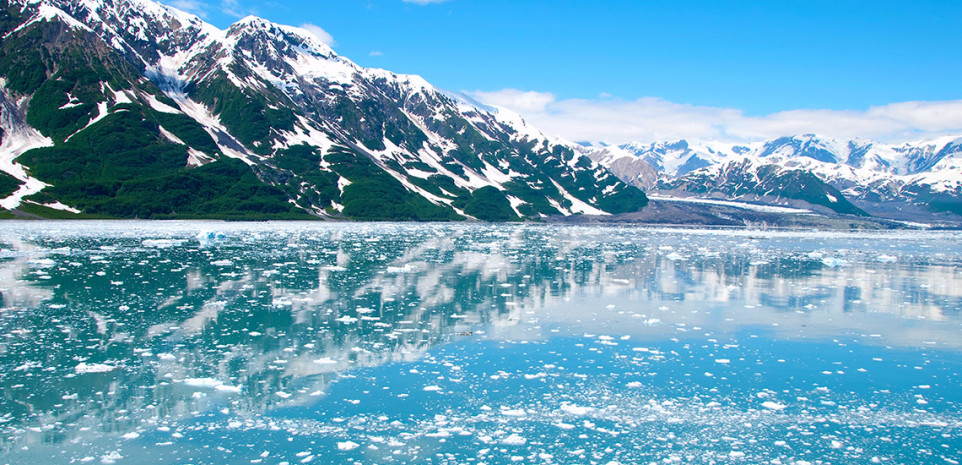
While anchoring off St Tropez or Cap Ferrat for weeks in August will always be in style, there has been an explosion in remote cruising, often fuelled by this younger, more adventurous set of yacht owners who can work from anywhere- Antarctica to Alaska and beyond.
This has fed into the next point…
A desire for adventure and exploration has changed yacht design.
As younger, more adventurous owners like tech billionaires have joined the superyacht market, the design of yachts and the toys they carry have changed markedly. New types of vessels have been created to meet this desire for off-the-beaten-track cruising, from support yachts to water toys to the massive growth in explorer yachts. Gone are the days when one yacht layout was almost identical to another. Now, we have winter gardens, submarines, ice rooms, ski rooms, large onboard offices, and helicopter hangars.
Not all of these changes have been driven by tech billionaires, granted. Still, their vision of what is possible has dramatically changed what yachts look like and how they operate as machines, with new types of propulsion, greater ranges, and a considerable amount more tech onboard.
Some things never change.
One thing hasn’t changed, though—a wealthy person’s desire for privacy. Discretion remains perhaps the most essential trait in any crew member, which you must keep in mind when working on yachts —even in the day of constant social media and shows like Below Deck.
A wealthy person’s desire for privacy and discretion is a constant that crew forget at their peril. Are you ensuring that you are a trusted asset? You may have signed that NDA, but do you let stories slip now and then at the bar? Are you careful about not taking photos onboard that give away anything about the boat or the owners? Do you make sure you don’t share the yacht’s cruising plans?
In a world where stories about tech billionaires will fly around the globe at light speed, you must be the gatekeeper. Stories cannot leave the passerelle.

Contact information
Sharon Rose
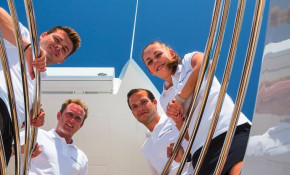
Related news

Navigating Success: Superyacht Industry Unveils Career Roadmaps with ’Raising the Bar’
Raising the Bar, a distinguished think tank comprised of experts from across the superyacht industry, is thrilled to announce the official launch of Superyacht Industry Careers. This groundbreaking initiative, developed through voluntary collaboration and graciously hosted by the Superyacht Alliance for Professional Standards, aims to provide comprehensive career maps tailored for superyacht crew across all departments.

Interview with Sheila, Founder of Source Training: Elevating Standards in Luxury Cleaning and Laundry
We had the privilege of sitting down with Sheila, the visionary founder behind Source Training, a pioneering platform that offers specialised training for luxury cleaning and laundry personnel in the yachting, chalet, and hotel industries. With decades of experience in the yachting world and a passion for preserving nature, Sheila shared her journey and insights into the need for professional training in these essential roles.
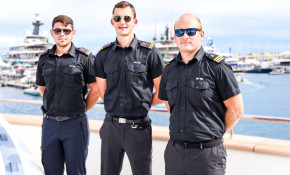
Stripes on Yachts: What Do They Mean?
Whether you are new to the yachting industry or an experienced professional, we’ve all asked ourselves the same question at least once in our career, “what do those stripes mean?” This article breaks down the meanings behind these cryptic stripes.
Find anything you save across the site in your account
The Haves and the Have-Yachts
By Evan Osnos
In the Victorian era, it was said that the length of a man’s boat, in feet, should match his age, in years. The Victorians would have had some questions at the fortieth annual Palm Beach International Boat Show, which convened this March on Florida’s Gold Coast. A typical offering: a two-hundred-and-three-foot superyacht named Sea Owl, selling secondhand for ninety million dollars. The owner, Robert Mercer, the hedge-fund tycoon and Republican donor, was throwing in furniture and accessories, including several auxiliary boats, a Steinway piano, a variety of frescoes, and a security system that requires fingerprint recognition. Nevertheless, Mercer’s package was a modest one; the largest superyachts are more than five hundred feet, on a scale with naval destroyers, and cost six or seven times what he was asking.
For the small, tight-lipped community around the world’s biggest yachts, the Palm Beach show has the promising air of spring training. On the cusp of the summer season, it affords brokers and builders and owners (or attendants from their family offices) a chance to huddle over the latest merchandise and to gather intelligence: Who’s getting in? Who’s getting out? And, most pressingly, who’s ogling a bigger boat?
On the docks, brokers parse the crowd according to a taxonomy of potential. Guests asking for tours face a gantlet of greeters, trained to distinguish “superrich clients” from “ineligible visitors,” in the words of Emma Spence, a former greeter at the Palm Beach show. Spence looked for promising clues (the right shoes, jewelry, pets) as well as for red flags (cameras, ornate business cards, clothes with pop-culture references). For greeters from elsewhere, Palm Beach is a challenging assignment. Unlike in Europe, where money can still produce some visible tells—Hunter Wellies, a Barbour jacket—the habits of wealth in Florida offer little that’s reliable. One colleague resorted to binoculars, to spot a passerby with a hundred-thousand-dollar watch. According to Spence, people judged to have insufficient buying power are quietly marked for “dissuasion.”
For the uninitiated, a pleasure boat the length of a football field can be bewildering. Andy Cohen, the talk-show host, recalled his first visit to a superyacht owned by the media mogul Barry Diller: “I was like the Beverly Hillbillies.” The boats have grown so vast that some owners place unique works of art outside the elevator on each deck, so that lost guests don’t barge into the wrong stateroom.
At the Palm Beach show, I lingered in front of a gracious vessel called Namasté, until I was dissuaded by a wooden placard: “Private yacht, no boarding, no paparazzi.” In a nearby berth was a two-hundred-and-eighty-foot superyacht called Bold, which was styled like a warship, with its own helicopter hangar, three Sea-Doos, two sailboats, and a color scheme of gunmetal gray. The rugged look is a trend; “explorer” vessels, equipped to handle remote journeys, are the sport-utility vehicles of yachting.
If you hail from the realm of ineligible visitors, you may not be aware that we are living through the “greatest boom in the yacht business that’s ever existed,” as Bob Denison—whose firm, Denison Yachting, is one of the world’s largest brokers—told me. “Every broker, every builder, up and down the docks, is having some of the best years they’ve ever experienced.” In 2021, the industry sold a record eight hundred and eighty-seven superyachts worldwide, nearly twice the previous year’s total. With more than a thousand new superyachts on order, shipyards are so backed up that clients unaccustomed to being told no have been shunted to waiting lists.
One reason for the increased demand for yachts is the pandemic. Some buyers invoke social distancing; others, an existential awakening. John Staluppi, of Palm Beach Gardens, who made a fortune from car dealerships, is looking to upgrade from his current, sixty-million-dollar yacht. “When you’re forty or fifty years old, you say, ‘I’ve got plenty of time,’ ” he told me. But, at seventy-five, he is ready to throw in an extra fifteen million if it will spare him three years of waiting. “Is your life worth five million dollars a year? I think so,” he said. A deeper reason for the demand is the widening imbalance of wealth. Since 1990, the United States’ supply of billionaires has increased from sixty-six to more than seven hundred, even as the median hourly wage has risen only twenty per cent. In that time, the number of truly giant yachts—those longer than two hundred and fifty feet—has climbed from less than ten to more than a hundred and seventy. Raphael Sauleau, the C.E.O. of Fraser Yachts, told me bluntly, “ COVID and wealth—a perfect storm for us.”
And yet the marina in Palm Beach was thrumming with anxiety. Ever since the Russian President, Vladimir Putin, launched his assault on Ukraine, the superyacht world has come under scrutiny. At a port in Spain, a Ukrainian engineer named Taras Ostapchuk, working aboard a ship that he said was owned by a Russian arms dealer, threw open the sea valves and tried to sink it to the bottom of the harbor. Under arrest, he told a judge, “I would do it again.” Then he returned to Ukraine and joined the military. Western allies, in the hope of pressuring Putin to withdraw, have sought to cut off Russian oligarchs from businesses and luxuries abroad. “We are coming for your ill-begotten gains,” President Joe Biden declared, in his State of the Union address.
Nobody can say precisely how many of Putin’s associates own superyachts—known to professionals as “white boats”—because the white-boat world is notoriously opaque. Owners tend to hide behind shell companies, registered in obscure tax havens, attended by private bankers and lawyers. But, with unusual alacrity, authorities have used subpoenas and police powers to freeze boats suspected of having links to the Russian élite. In Spain, the government detained a hundred-and-fifty-million-dollar yacht associated with Sergei Chemezov, the head of the conglomerate Rostec, whose bond with Putin reaches back to their time as K.G.B. officers in East Germany. (As in many cases, the boat is not registered to Chemezov; the official owner is a shell company connected to his stepdaughter, a teacher whose salary is likely about twenty-two hundred dollars a month.) In Germany, authorities impounded the world’s most voluminous yacht, Dilbar, for its ties to the mining-and-telecom tycoon Alisher Usmanov. And in Italy police have grabbed a veritable armada, including a boat owned by one of Russia’s richest men, Alexei Mordashov, and a colossus suspected of belonging to Putin himself, the four-hundred-and-fifty-nine-foot Scheherazade.
In Palm Beach, the yachting community worried that the same scrutiny might be applied to them. “Say your superyacht is in Asia, and there’s some big conflict where China invades Taiwan,” Denison told me. “China could spin it as ‘Look at these American oligarchs!’ ” He wondered if the seizures of superyachts marked a growing political animus toward the very rich. “Whenever things are economically or politically disruptive,” he said, “it’s hard to justify taking an insane amount of money and just putting it into something that costs a lot to maintain, depreciates, and is only used for having a good time.”
Nobody pretends that a superyacht is a productive place to stash your wealth. In a column this spring headlined “ A SUPERYACHT IS A TERRIBLE ASSET ,” the Financial Times observed, “Owning a superyacht is like owning a stack of 10 Van Goghs, only you are holding them over your head as you tread water, trying to keep them dry.”
Not so long ago, status transactions among the élite were denominated in Old Masters and in the sculptures of the Italian Renaissance. Joseph Duveen, the dominant art dealer of the early twentieth century, kept the oligarchs of his day—Andrew Mellon, Jules Bache, J. P. Morgan—jockeying over Donatellos and Van Dycks. “When you pay high for the priceless,” he liked to say, “you’re getting it cheap.”

Link copied
In the nineteen-fifties, the height of aspirational style was fine French furniture—F.F.F., as it became known in certain precincts of Fifth Avenue and Palm Beach. Before long, more and more money was going airborne. Hugh Hefner, a pioneer in the private-jet era, decked out a plane he called Big Bunny, where he entertained Elvis Presley, Raquel Welch, and James Caan. The oil baron Armand Hammer circled the globe on his Boeing 727, paying bribes and recording evidence on microphones hidden in his cufflinks. But, once it seemed that every plutocrat had a plane, the thrill was gone.
In any case, an airplane is just transportation. A big ship is a floating manse, with a hierarchy written right into the nomenclature. If it has a crew working aboard, it’s a yacht. If it’s more than ninety-eight feet, it’s a superyacht. After that, definitions are debated, but people generally agree that anything more than two hundred and thirty feet is a megayacht, and more than two hundred and ninety-five is a gigayacht. The world contains about fifty-four hundred superyachts, and about a hundred gigayachts.
For the moment, a gigayacht is the most expensive item that our species has figured out how to own. In 2019, the hedge-fund billionaire Ken Griffin bought a quadruplex on Central Park South for two hundred and forty million dollars, the highest price ever paid for a home in America. In May, an unknown buyer spent about a hundred and ninety-five million on an Andy Warhol silk-screen portrait of Marilyn Monroe. In luxury-yacht terms, those are ordinary numbers. “There are a lot of boats in build well over two hundred and fifty million dollars,” Jamie Edmiston, a broker in Monaco and London, told me. His buyers are getting younger and more inclined to spend long stretches at sea. “High-speed Internet, telephony, modern communications have made working easier,” he said. “Plus, people made a lot more money earlier in life.”
A Silicon Valley C.E.O. told me that one appeal of boats is that they can “absorb the most excess capital.” He explained, “Rationally, it would seem to make sense for people to spend half a billion dollars on their house and then fifty million on the boat that they’re on for two weeks a year, right? But it’s gone the other way. People don’t want to live in a hundred-thousand-square-foot house. Optically, it’s weird. But a half-billion-dollar boat, actually, is quite nice.” Staluppi, of Palm Beach Gardens, is content to spend three or four times as much on his yachts as on his homes. Part of the appeal is flexibility. “If you’re on your boat and you don’t like your neighbor, you tell the captain, ‘Let’s go to a different place,’ ” he said. On land, escaping a bad neighbor requires more work: “You got to try and buy him out or make it uncomfortable or something.” The preference for sea-based investment has altered the proportions of taste. Until recently, the Silicon Valley C.E.O. said, “a fifty-metre boat was considered a good-sized boat. Now that would be a little bit embarrassing.” In the past twenty years, the length of the average luxury yacht has grown by a third, to a hundred and sixty feet.
Thorstein Veblen, the economist who published “The Theory of the Leisure Class,” in 1899, argued that the power of “conspicuous consumption” sprang not from artful finery but from sheer needlessness. “In order to be reputable,” he wrote, “it must be wasteful.” In the yachting world, stories circulate about exotic deliveries by helicopter or seaplane: Dom Pérignon, bagels from Zabar’s, sex workers, a rare melon from the island of Hokkaido. The industry excels at selling you things that you didn’t know you needed. When you flip through the yachting press, it’s easy to wonder how you’ve gone this long without a personal submarine, or a cryosauna that “blasts you with cold” down to minus one hundred and ten degrees Celsius, or the full menagerie of “exclusive leathers,” such as eel and stingray.
But these shrines to excess capital exist in a conditional state of visibility: they are meant to be unmistakable to a slender stratum of society—and all but unseen by everyone else. Even before Russia’s invasion of Ukraine, the yachting community was straining to manage its reputation as a gusher of carbon emissions (one well-stocked diesel yacht is estimated to produce as much greenhouse gas as fifteen hundred passenger cars), not to mention the fact that the world of white boats is overwhelmingly white. In a candid aside to a French documentarian, the American yachtsman Bill Duker said, “If the rest of the world learns what it’s like to live on a yacht like this, they’re gonna bring back the guillotine.” The Dutch press recently reported that Jeff Bezos, the founder of Amazon, was building a sailing yacht so tall that the city of Rotterdam might temporarily dismantle a bridge that had survived the Nazis in order to let the boat pass to the open sea. Rotterdammers were not pleased. On Facebook, a local man urged people to “take a box of rotten eggs with you and let’s throw them en masse at Jeff’s superyacht when it sails through.” At least thirteen thousand people expressed interest. Amid the uproar, a deputy mayor announced that the dismantling plan had been abandoned “for the time being.” (Bezos modelled his yacht partly on one owned by his friend Barry Diller, who has hosted him many times. The appreciation eventually extended to personnel, and Bezos hired one of Diller’s captains.)
As social media has heightened the scrutiny of extraordinary wealth, some of the very people who created those platforms have sought less observable places to spend it. But they occasionally indulge in some coded provocation. In 2006, when the venture capitalist Tom Perkins unveiled his boat in Istanbul, most passersby saw it adorned in colorful flags, but people who could read semaphore were able to make out a message: “Rarely does one have the privilege to witness vulgar ostentation displayed on such a scale.” As a longtime owner told me, “If you don’t have some guilt about it, you’re a rat.”
Alex Finley, a former C.I.A. officer who has seen yachts proliferate near her home in Barcelona, has weighed the superyacht era and its discontents in writings and on Twitter, using the hashtag #YachtWatch. “To me, the yachts are not just yachts,” she told me. “In Russia’s case, these are the embodiment of oligarchs helping a dictator destabilize our democracy while utilizing our democracy to their benefit.” But, Finley added, it’s a mistake to think the toxic symbolism applies only to Russia. “The yachts tell a whole story about a Faustian capitalism—this idea that we’re ready to sell democracy for short-term profit,” she said. “They’re registered offshore. They use every loophole that we’ve put in place for illicit money and tax havens. So they play a role in this battle, writ large, between autocracy and democracy.”
After a morning on the docks at the Palm Beach show, I headed to a more secluded marina nearby, which had been set aside for what an attendant called “the really big hardware.” It felt less like a trade show than like a boutique resort, with a swimming pool and a terrace restaurant. Kevin Merrigan, a relaxed Californian with horn-rimmed glasses and a high forehead pinked by the sun, was waiting for me at the stern of Unbridled, a superyacht with a brilliant blue hull that gave it the feel of a personal cruise ship. He invited me to the bridge deck, where a giant screen showed silent video of dolphins at play.
Merrigan is the chairman of the brokerage Northrop & Johnson, which has ridden the tide of growing boats and wealth since 1949. Lounging on a sofa mounded with throw pillows, he projected a nearly postcoital level of contentment. He had recently sold the boat we were on, accepted an offer for a behemoth beside us, and begun negotiating the sale of yet another. “This client owns three big yachts,” he said. “It’s a hobby for him. We’re at a hundred and ninety-one feet now, and last night he said, ‘You know, what do you think about getting a two hundred and fifty?’ ” Merrigan laughed. “And I was, like, ‘Can’t you just have dinner?’ ”
Among yacht owners, there are some unwritten rules of stratification: a Dutch-built boat will hold its value better than an Italian; a custom design will likely get more respect than a “series yacht”; and, if you want to disparage another man’s boat, say that it looks like a wedding cake. But, in the end, nothing says as much about a yacht, or its owner, as the delicate matter of L.O.A.—length over all.
The imperative is not usually length for length’s sake (though the longtime owner told me that at times there is an aspect of “phallic sizing”). “L.O.A.” is a byword for grandeur. In most cases, pleasure yachts are permitted to carry no more than twelve passengers, a rule set by the International Convention for the Safety of Life at Sea, which was conceived after the sinking of the Titanic. But those limits do not apply to crew. “So, you might have anything between twelve and fifty crew looking after those twelve guests,” Edmiston, the broker, said. “It’s a level of service you cannot really contemplate until you’ve been fortunate enough to experience it.”
As yachts have grown more capacious, and the limits on passengers have not, more and more space on board has been devoted to staff and to novelties. The latest fashions include IMAX theatres, hospital equipment that tests for dozens of pathogens, and ski rooms where guests can suit up for a helicopter trip to a mountaintop. The longtime owner, who had returned the previous day from his yacht, told me, “No one today—except for assholes and ridiculous people—lives on land in what you would call a deep and broad luxe life. Yes, people have nice houses and all of that, but it’s unlikely that the ratio of staff to them is what it is on a boat.” After a moment, he added, “Boats are the last place that I think you can get away with it.”
Even among the truly rich, there is a gap between the haves and the have-yachts. One boating guest told me about a conversation with a famous friend who keeps one of the world’s largest yachts. “He said, ‘The boat is the last vestige of what real wealth can do.’ What he meant is, You have a chef, and I have a chef. You have a driver, and I have a driver. You can fly privately, and I fly privately. So, the one place where I can make clear to the world that I am in a different fucking category than you is the boat.”
After Merrigan and I took a tour of Unbridled, he led me out to a waiting tender, staffed by a crew member with an earpiece on a coil. The tender, Merrigan said, would ferry me back to the busy main dock of the Palm Beach show. We bounced across the waves under a pristine sky, and pulled into the marina, where my fellow-gawkers were still trying to talk their way past the greeters. As I walked back into the scrum, Namasté was still there, but it looked smaller than I remembered.
For owners and their guests, a white boat provides a discreet marketplace for the exchange of trust, patronage, and validation. To diagram the precise workings of that trade—the customs and anxieties, strategies and slights—I talked to Brendan O’Shannassy, a veteran captain who is a curator of white-boat lore. Raised in Western Australia, O’Shannassy joined the Navy as a young man, and eventually found his way to skippering some of the world’s biggest yachts. He has worked for Paul Allen, the late co-founder of Microsoft, along with a few other billionaires he declines to name. Now in his early fifties, with patient green eyes and tufts of curly brown hair, O’Shannassy has had a vantage from which to monitor the social traffic. “It’s all gracious, and everyone’s kiss-kiss,” he said. “But there’s a lot going on in the background.”
O’Shannassy once worked for an owner who limited the number of newspapers on board, so that he could watch his guests wait and squirm. “It was a mind game amongst the billionaires. There were six couples, and three newspapers,” he said, adding, “They were ranking themselves constantly.” On some boats, O’Shannassy has found himself playing host in the awkward minutes after guests arrive. “A lot of them are savants, but some are very un-socially aware,” he said. “They need someone to be social and charming for them.” Once everyone settles in, O’Shannassy has learned, there is often a subtle shift, when a mogul or a politician or a pop star starts to loosen up in ways that are rarely possible on land. “Your security is relaxed—they’re not on your hip,” he said. “You’re not worried about paparazzi. So you’ve got all this extra space, both mental and physical.”
O’Shannassy has come to see big boats as a space where powerful “solar systems” converge and combine. “It is implicit in every interaction that their sharing of information will benefit both parties; it is an obsession with billionaires to do favours for each other. A referral, an introduction, an insight—it all matters,” he wrote in “Superyacht Captain,” a new memoir. A guest told O’Shannassy that, after a lavish display of hospitality, he finally understood the business case for buying a boat. “One deal secured on board will pay it all back many times over,” the guest said, “and it is pretty hard to say no after your kids have been hosted so well for a week.”
Take the case of David Geffen, the former music and film executive. He is long retired, but he hosts friends (and potential friends) on the four-hundred-and-fifty-four-foot Rising Sun, which has a double-height cinema, a spa and salon, and a staff of fifty-seven. In 2017, shortly after Barack and Michelle Obama departed the White House, they were photographed on Geffen’s boat in French Polynesia, accompanied by Bruce Springsteen, Oprah Winfrey, Tom Hanks, and Rita Wilson. For Geffen, the boat keeps him connected to the upper echelons of power. There are wealthier Americans, but not many of them have a boat so delectable that it can induce both a Democratic President and the workingman’s crooner to risk the aroma of hypocrisy.
The binding effect pays dividends for guests, too. Once people reach a certain level of fame, they tend to conclude that its greatest advantage is access. Spend a week at sea together, lingering over meals, observing one another floundering on a paddleboard, and you have something of value for years to come. Call to ask for an investment, an introduction, an internship for a wayward nephew, and you’ll at least get the call returned. It’s a mutually reinforcing circle of validation: she’s here, I’m here, we’re here.
But, if you want to get invited back, you are wise to remember your part of the bargain. If you work with movie stars, bring fresh gossip. If you’re on Wall Street, bring an insight or two. Don’t make the transaction obvious, but don’t forget why you’re there. “When I see the guest list,” O’Shannassy wrote, “I am aware, even if not all names are familiar, that all have been chosen for a purpose.”
For O’Shannassy, there is something comforting about the status anxieties of people who have everything. He recalled a visit to the Italian island of Sardinia, where his employer asked him for a tour of the boats nearby. Riding together on a tender, they passed one colossus after another, some twice the size of the owner’s superyacht. Eventually, the man cut the excursion short. “Take me back to my yacht, please,” he said. They motored in silence for a while. “There was a time when my yacht was the most beautiful in the bay,” he said at last. “How do I keep up with this new money?”
The summer season in the Mediterranean cranks up in May, when the really big hardware heads east from Florida and the Caribbean to escape the coming hurricanes, and reconvenes along the coasts of France, Italy, and Spain. At the center is the Principality of Monaco, the sun-washed tax haven that calls itself the “world’s capital of advanced yachting.” In Monaco, which is among the richest countries on earth, superyachts bob in the marina like bath toys.

The nearest hotel room at a price that would not get me fired was an Airbnb over the border with France. But an acquaintance put me on the phone with the Yacht Club de Monaco, a members-only establishment created by the late monarch His Serene Highness Prince Rainier III, whom the Web site describes as “a true visionary in every respect.” The club occasionally rents rooms—“cabins,” as they’re called—to visitors in town on yacht-related matters. Claudia Batthyany, the elegant director of special projects, showed me to my cabin and later explained that the club does not aspire to be a hotel. “We are an association ,” she said. “Otherwise, it becomes”—she gave a gentle wince—“not that exclusive.”
Inside my cabin, I quickly came to understand that I would never be fully satisfied anywhere else again. The space was silent and aromatically upscale, bathed in soft sunlight that swept through a wall of glass overlooking the water. If I was getting a sudden rush of the onboard experience, that was no accident. The clubhouse was designed by the British architect Lord Norman Foster to evoke the opulent indulgence of ocean liners of the interwar years, like the Queen Mary. I found a handwritten welcome note, on embossed club stationery, set alongside an orchid and an assemblage of chocolate truffles: “The whole team remains at your entire disposal to make your stay a wonderful experience. Yours sincerely, Service Members.” I saluted the nameless Service Members, toiling for the comfort of their guests. Looking out at the water, I thought, intrusively, of a line from Santiago, Hemingway’s old man of the sea. “Do not think about sin,” he told himself. “It is much too late for that and there are people who are paid to do it.”
I had been assured that the Service Members would cheerfully bring dinner, as they might on board, but I was eager to see more of my surroundings. I consulted the club’s summer dress code. It called for white trousers and a blue blazer, and it discouraged improvisation: “No pocket handkerchief is to be worn above the top breast-pocket bearing the Club’s coat of arms.” The handkerchief rule seemed navigable, but I did not possess white trousers, so I skirted the lobby and took refuge in the bar. At a table behind me, a man with flushed cheeks and a British accent had a head start. “You’re a shitty negotiator,” he told another man, with a laugh. “Maybe sales is not your game.” A few seats away, an American woman was explaining to a foreign friend how to talk with conservatives: “If they say, ‘The earth is flat,’ you say, ‘Well, I’ve sailed around it, so I’m not so sure about that.’ ”
In the morning, I had an appointment for coffee with Gaëlle Tallarida, the managing director of the Monaco Yacht Show, which the Daily Mail has called the “most shamelessly ostentatious display of yachts in the world.” Tallarida was not born to that milieu; she grew up on the French side of the border, swimming at public beaches with a view of boats sailing from the marina. But she had a knack for highly organized spectacle. While getting a business degree, she worked on a student theatre festival and found it thrilling. Afterward, she got a job in corporate events, and in 1998 she was hired at the yacht show as a trainee.
With this year’s show five months off, Tallarida was already getting calls about what she described as “the most complex part of my work”: deciding which owners get the most desirable spots in the marina. “As you can imagine, they’ve got very big egos,” she said. “On top of that, I’m a woman. They are sometimes arriving and saying”—she pointed into the distance, pantomiming a decree—“ ‘O.K., I want that! ’ ”
Just about everyone wants his superyacht to be viewed from the side, so that its full splendor is visible. Most harbors, however, have a limited number of berths with a side view; in Monaco, there are only twelve, with prime spots arrayed along a concrete dike across from the club. “We reserve the dike for the biggest yachts,” Tallarida said. But try telling that to a man who blew his fortune on a small superyacht.
Whenever possible, Tallarida presents her verdicts as a matter of safety: the layout must insure that “in case of an emergency, any boat can go out.” If owners insist on preferential placement, she encourages a yachting version of the Golden Rule: “What if, next year, I do that to you? Against you?”
Does that work? I asked. She shrugged. “They say, ‘Eh.’ ” Some would gladly risk being a victim next year in order to be a victor now. In the most awful moment of her career, she said, a man who was unhappy with his berth berated her face to face. “I was in the office, feeling like a little girl, with my daddy shouting at me. I said, ‘O.K., O.K., I’m going to give you the spot.’ ”
Securing just the right place, it must be said, carries value. Back at the yacht club, I was on my terrace, enjoying the latest delivery by the Service Members—an airy French omelette and a glass of preternaturally fresh orange juice. I thought guiltily of my wife, at home with our kids, who had sent a text overnight alerting me to a maintenance issue that she described as “a toilet debacle.”
Then I was distracted by the sight of a man on a yacht in the marina below. He was staring up at me. I went back to my brunch, but, when I looked again, there he was—a middle-aged man, on a mid-tier yacht, juiceless, on a greige banquette, staring up at my perfect terrace. A surprising sensation started in my chest and moved outward like a warm glow: the unmistakable pang of superiority.
That afternoon, I made my way to the bar, to meet the yacht club’s general secretary, Bernard d’Alessandri, for a history lesson. The general secretary was up to code: white trousers, blue blazer, club crest over the heart. He has silver hair, black eyebrows, and a tan that evokes high-end leather. “I was a sailing teacher before this,” he said, and gestured toward the marina. “It was not like this. It was a village.”
Before there were yacht clubs, there were jachten , from the Dutch word for “hunt.” In the seventeenth century, wealthy residents of Amsterdam created fast-moving boats to meet incoming cargo ships before they hit port, in order to check out the merchandise. Soon, the Dutch owners were racing one another, and yachting spread across Europe. After a visit to Holland in 1697, Peter the Great returned to Russia with a zeal for pleasure craft, and he later opened Nevsky Flot, one of the world’s first yacht clubs, in St. Petersburg.
For a while, many of the biggest yachts were symbols of state power. In 1863, the viceroy of Egypt, Isma’il Pasha, ordered up a steel leviathan called El Mahrousa, which was the world’s longest yacht for a remarkable hundred and nineteen years, until the title was claimed by King Fahd of Saudi Arabia. In the United States, Franklin Delano Roosevelt received guests aboard the U.S.S. Potomac, which had a false smokestack containing a hidden elevator, so that the President could move by wheelchair between decks.
But yachts were finding new patrons outside politics. In 1954, the Greek shipping baron Aristotle Onassis bought a Canadian Navy frigate and spent four million dollars turning it into Christina O, which served as his home for months on end—and, at various times, as a home to his companions Maria Callas, Greta Garbo, and Jacqueline Kennedy. Christina O had its flourishes—a Renoir in the master suite, a swimming pool with a mosaic bottom that rose to become a dance floor—but none were more distinctive than the appointments in the bar, which included whales’ teeth carved into pornographic scenes from the Odyssey and stools upholstered in whale foreskins.
For Onassis, the extraordinary investments in Christina O were part of an epic tit for tat with his archrival, Stavros Niarchos, a fellow shipping tycoon, which was so entrenched that it continued even after Onassis’s death, in 1975. Six years later, Niarchos launched a yacht fifty-five feet longer than Christina O: Atlantis II, which featured a swimming pool on a gyroscope so that the water would not slosh in heavy seas. Atlantis II, now moored in Monaco, sat before the general secretary and me as we talked.
Over the years, d’Alessandri had watched waves of new buyers arrive from one industry after another. “First, it was the oil. After, it was the telecommunications. Now, they are making money with crypto,” he said. “And, each time, it’s another size of the boat, another design.” What began as symbols of state power had come to represent more diffuse aristocracies—the fortunes built on carbon, capital, and data that migrated across borders. As early as 1908, the English writer G. K. Chesterton wondered what the big boats foretold of a nation’s fabric. “The poor man really has a stake in the country,” he wrote. “The rich man hasn’t; he can go away to New Guinea in a yacht.”
Each iteration of fortune left its imprint on the industry. Sheikhs, who tend to cruise in the world’s hottest places, wanted baroque indoor spaces and were uninterested in sundecks. Silicon Valley favored acres of beige, more Sonoma than Saudi. And buyers from Eastern Europe became so abundant that shipyards perfected the onboard banya , a traditional Russian sauna stocked with birch and eucalyptus. The collapse of the Soviet Union, in 1991, had minted a generation of new billionaires, whose approach to money inspired a popular Russian joke: One oligarch brags to another, “Look at this new tie. It cost me two hundred bucks!” To which the other replies, “You moron. You could’ve bought the same one for a thousand!”
In 1998, around the time that the Russian economy imploded, the young tycoon Roman Abramovich reportedly bought a secondhand yacht called Sussurro—Italian for “whisper”—which had been so carefully engineered for speed that each individual screw was weighed before installation. Soon, Russians were competing to own the costliest ships. “If the most expensive yacht in the world was small, they would still want it,” Maria Pevchikh, a Russian investigator who helps lead the Anti-Corruption Foundation, told me.
In 2008, a thirty-six-year-old industrialist named Andrey Melnichenko spent some three hundred million dollars on Motor Yacht A, a radical experiment conceived by the French designer Philippe Starck, with a dagger-shaped hull and a bulbous tower topped by a master bedroom set on a turntable that pivots to capture the best view. The shape was ridiculed as “a giant finger pointing at you” and “one of the most hideous vessels ever to sail,” but it marked a new prominence for Russian money at sea. Today, post-Soviet élites are thought to own a fifth of the world’s gigayachts.
Even Putin has signalled his appreciation, being photographed on yachts in the Black Sea resort of Sochi. In an explosive report in 2012, Boris Nemtsov, a former Deputy Prime Minister, accused Putin of amassing a storehouse of outrageous luxuries, including four yachts, twenty homes, and dozens of private aircraft. Less than three years later, Nemtsov was fatally shot while crossing a bridge near the Kremlin. The Russian government, which officially reports that Putin collects a salary of about a hundred and forty thousand dollars and possesses a modest apartment in Moscow, denied any involvement.
Many of the largest, most flamboyant gigayachts are designed in Monaco, at a sleek waterfront studio occupied by the naval architect Espen Øino. At sixty, Øino has a boyish mop and the mild countenance of a country parson. He grew up in a small town in Norway, the heir to a humble maritime tradition. “My forefathers built wooden rowing boats for four generations,” he told me. In the late eighties, he was designing sailboats when his firm won a commission to design a megayacht for Emilio Azcárraga, the autocratic Mexican who built Televisa into the world’s largest Spanish-language broadcaster. Azcárraga was nicknamed El Tigre, for his streak of white hair and his comfort with confrontation; he kept a chair in his office that was unusually high off the ground, so that visitors’ feet dangled like children’s.
In early meetings, Øino recalled, Azcárraga grew frustrated that the ideas were not dazzling enough. “You must understand,” he said. “I don’t go to port very often with my boats, but, when I do, I want my presence to be felt.”
The final design was suitably arresting; after the boat was completed, Øino had no shortage of commissions. In 1998, he was approached by Paul Allen, of Microsoft, to build a yacht that opened the way for the Goliaths that followed. The result, called Octopus, was so large that it contained a submarine marina in its belly, as well as a helicopter hangar that could be converted into an outdoor performance space. Mick Jagger and Bono played on occasion. I asked Øino why owners obsessed with secrecy seem determined to build the world’s most conspicuous machines. He compared it to a luxury car with tinted windows. “People can’t see you, but you’re still in that expensive, impressive thing,” he said. “We all need to feel that we’re important in one way or another.”

In recent months, Øino has seen some of his creations detained by governments in the sanctions campaign. When we spoke, he condemned the news coverage. “Yacht equals Russian equals evil equals money,” he said disdainfully. “It’s a bit tragic, because the yachts have become synonymous with the bad guys in a James Bond movie.”
What about Scheherazade, the giant yacht that U.S. officials have alleged is held by a Russian businessman for Putin’s use? Øino, who designed the ship, rejected the idea. “We have designed two yachts for heads of state, and I can tell you that they’re completely different, in terms of the layout and everything, from Scheherazade.” He meant that the details said plutocrat, not autocrat.
For the time being, Scheherazade and other Øino creations under detention across Europe have entered a strange legal purgatory. As lawyers for the owners battle to keep the ships from being permanently confiscated, local governments are duty-bound to maintain them until a resolution is reached. In a comment recorded by a hot mike in June, Jake Sullivan, the U.S. national-security adviser, marvelled that “people are basically being paid to maintain Russian superyachts on behalf of the United States government.” (It usually costs about ten per cent of a yacht’s construction price to keep it afloat each year. In May, officials in Fiji complained that a detained yacht was costing them more than a hundred and seventy-one thousand dollars a day.)
Stranger still are the Russian yachts on the lam. Among them is Melnichenko’s much maligned Motor Yacht A. On March 9th, Melnichenko was sanctioned by the European Union, and although he denied having close ties to Russia’s leadership, Italy seized one of his yachts—a six-hundred-million-dollar sailboat. But Motor Yacht A slipped away before anyone could grab it. Then the boat turned off the transponder required by international maritime rules, so that its location could no longer be tracked. The last ping was somewhere near the Maldives, before it went dark on the high seas.
The very largest yachts come from Dutch and German shipyards, which have experience in naval vessels, known as “gray boats.” But the majority of superyachts are built in Italy, partly because owners prefer to visit the Mediterranean during construction. (A British designer advises those who are weighing their choices to take the geography seriously, “unless you like schnitzel.”)
In the past twenty-two years, nobody has built more superyachts than the Vitellis, an Italian family whose patriarch, Paolo Vitelli, got his start in the seventies, manufacturing smaller boats near a lake in the mountains. By 1985, their company, Azimut, had grown large enough to buy the Benetti shipyards, which had been building enormous yachts since the nineteenth century. Today, the combined company builds its largest boats near the sea, but the family still works in the hill town of Avigliana, where a medieval monastery towers above a valley. When I visited in April, Giovanna Vitelli, the vice-president and the founder’s daughter, led me through the experience of customizing a yacht.
“We’re using more and more virtual reality,” she said, and a staffer fitted me with a headset. When the screen blinked on, I was inside a 3-D mockup of a yacht that is not yet on the market. I wandered around my suite for a while, checking out swivel chairs, a modish sideboard, blond wood panelling on the walls. It was convincing enough that I collided with a real-life desk.
After we finished with the headset, it was time to pick the décor. The industry encourages an introspective evaluation: What do you want your yacht to say about you? I was handed a vibrant selection of wood, marble, leather, and carpet. The choices felt suddenly grave. Was I cut out for the chiselled look of Cream Vesuvio, or should I accept that I’m a gray Cardoso Stone? For carpets, I liked the idea of Chablis Corn White—Paris and the prairie, together at last. But, for extra seating, was it worth splurging for the V.I.P. Vanity Pouf?
Some designs revolve around a single piece of art. The most expensive painting ever sold, Leonardo da Vinci’s “Salvator Mundi,” reportedly was hung on the Saudi crown prince Mohammed bin Salman’s four-hundred-and-thirty-nine-foot yacht Serene, after the Louvre rejected a Saudi demand that it hang next to the “Mona Lisa.” Art conservators blanched at the risks that excess humidity and fluctuating temperatures could pose to a five-hundred-year-old painting. Often, collectors who want to display masterpieces at sea commission replicas.
If you’ve just put half a billion dollars into a boat, you may have qualms about the truism that material things bring less happiness than experiences do. But this, too, can be finessed. Andrew Grant Super, a co-founder of the “experiential yachting” firm Berkeley Rand, told me that he served a uniquely overstimulated clientele: “We call them the bored billionaires.” He outlined a few of his experience products. “We can plot half of the Pacific Ocean with coördinates, to map out the Battle of Midway,” he said. “We re-create the full-blown battles of the giant ships from America and Japan. The kids have haptic guns and haptic vests. We put the smell of cordite and cannon fire on board, pumping around them.” For those who aren’t soothed by the scent of cordite, Super offered an alternative. “We fly 3-D-printed, architectural freestanding restaurants into the middle of the Maldives, on a sand shelf that can only last another eight hours before it disappears.”
For some, the thrill lies in the engineering. Staluppi, born in Brooklyn, was an auto mechanic who had no experience with the sea until his boss asked him to soup up a boat. “I took the six-cylinder engines out and put V-8 engines in,” he recalled. Once he started commissioning boats of his own, he built scale models to conduct tests in water tanks. “I knew I could never have the biggest boat in the world, so I says, ‘You know what? I want to build the fastest yacht in the world.’ The Aga Khan had the fastest yacht, and we just blew right by him.”
In Italy, after decking out my notional yacht, I headed south along the coast, to Tuscan shipyards that have evolved with each turn in the country’s history. Close to the Carrara quarries, which yielded the marble that Michelangelo turned into David, ships were constructed in the nineteenth century, to transport giant blocks of stone. Down the coast, the yards in Livorno made warships under the Fascists, until they were bombed by the Allies. Later, they began making and refitting luxury yachts. Inside the front gate of a Benetti shipyard in Livorno, a set of models depicted the firm’s famous modern creations. Most notable was the megayacht Nabila, built in 1980 for the high-living arms dealer Adnan Khashoggi, with a hundred rooms and a disco that was the site of legendary decadence. (Khashoggi’s budget for prostitution was so extravagant that a French prosecutor later estimated he paid at least half a million dollars to a single madam in a single year.)
In 1987, shortly before Khashoggi was indicted for mail fraud and obstruction of justice (he was eventually acquitted), the yacht was sold to the real-estate developer Donald Trump, who renamed it Trump Princess. Trump was never comfortable on a boat—“Couldn’t get off fast enough,” he once said—but he liked to impress people with his yacht’s splendor. In 1991, while three billion dollars in debt, Trump ceded the vessel to creditors. Later in life, though, he discovered enthusiastic support among what he called “our beautiful boaters,” and he came to see quality watercraft as a mark of virtue—a way of beating the so-called élite. “We got better houses, apartments, we got nicer boats, we’re smarter than they are,” he told a crowd in Fargo, North Dakota. “Let’s call ourselves, from now on, the super-élite.”
In the age of oversharing, yachts are a final sanctum of secrecy, even for some of the world’s most inveterate talkers. Oprah, after returning from her sojourn with the Obamas, rebuffed questions from reporters. “What happens on the boat stays on the boat,” she said. “We talked, and everybody else did a lot of paddleboarding.”
I interviewed six American superyacht owners at length, and almost all insisted on anonymity or held forth with stupefying blandness. “Great family time,” one said. Another confessed, “It’s really hard to talk about it without being ridiculed.” None needed to be reminded of David Geffen’s misadventure during the early weeks of the pandemic, when he Instagrammed a photo of his yacht in the Grenadines and posted that he was “avoiding the virus” and “hoping everybody is staying safe.” It drew thousands of responses, many marked #EatTheRich, others summoning a range of nautical menaces: “At least the pirates have his location now.”
The yachts extend a tradition of seclusion as the ultimate luxury. The Medici, in sixteenth-century Florence, built elevated passageways, or corridoi , high over the city to escape what a scholar called the “clash of classes, the randomness, the smells and confusions” of pedestrian life below. More recently, owners of prized town houses in London have headed in the other direction, building three-story basements so vast that their construction can require mining engineers—a trend that researchers in the United Kingdom named “luxified troglodytism.”
Water conveys a particular autonomy, whether it’s ringing the foot of a castle or separating a private island from the mainland. Peter Thiel, the billionaire venture capitalist, gave startup funding to the Seasteading Institute, a nonprofit group co-founded by Milton Friedman’s grandson, which seeks to create floating mini-states—an endeavor that Thiel considered part of his libertarian project to “escape from politics in all its forms.” Until that fantasy is realized, a white boat can provide a start. A recent feature in Boat International , a glossy trade magazine, noted that the new hundred-and-twenty-five-million-dollar megayacht Victorious has four generators and “six months’ autonomy” at sea. The builder, Vural Ak, explained, “In case of emergency, god forbid, you can live in open water without going to shore and keep your food stored, make your water from the sea.”
Much of the time, superyachts dwell beyond the reach of ordinary law enforcement. They cruise in international waters, and, when they dock, local cops tend to give them a wide berth; the boats often have private security, and their owners may well be friends with the Prime Minister. According to leaked documents known as the Paradise Papers, handlers proposed that the Saudi crown prince take delivery of a four-hundred-and-twenty-million-dollar yacht in “international waters in the western Mediterranean,” where the sale could avoid taxes.
Builders and designers rarely advertise beyond the trade press, and they scrupulously avoid leaks. At Lürssen, a German shipbuilding firm, projects are described internally strictly by reference number and code name. “We are not in the business for the glory,” Peter Lürssen, the C.E.O., told a reporter. The closest thing to an encyclopedia of yacht ownership is a site called SuperYachtFan, run by a longtime researcher who identifies himself only as Peter, with a disclaimer that he relies partly on “rumors” but makes efforts to confirm them. In an e-mail, he told me that he studies shell companies, navigation routes, paparazzi photos, and local media in various languages to maintain a database with more than thirteen hundred supposed owners. Some ask him to remove their names, but he thinks that members of that economic echelon should regard the attention as a “fact of life.”
To work in the industry, staff must adhere to the culture of secrecy, often enforced by N.D.A.s. On one yacht, O’Shannassy, the captain, learned to communicate in code with the helicopter pilot who regularly flew the owner from Switzerland to the Mediterranean. Before takeoff, the pilot would call with a cryptic report on whether the party included the presence of a Pomeranian. If any guest happened to overhear, their cover story was that a customs declaration required details about pets. In fact, the lapdog was a constant companion of the owner’s wife; if the Pomeranian was in the helicopter, so was she. “If no dog was in the helicopter,” O’Shannassy recalled, the owner was bringing “somebody else.” It was the captain’s duty to rebroadcast the news across the yacht’s internal radio: “Helicopter launched, no dog, I repeat no dog today”—the signal for the crew to ready the main cabin for the mistress, instead of the wife. They swapped out dresses, family photos, bathroom supplies, favored drinks in the fridge. On one occasion, the code got garbled, and the helicopter landed with an unanticipated Pomeranian. Afterward, the owner summoned O’Shannassy and said, “Brendan, I hope you never have such a situation, but if you do I recommend making sure the correct dresses are hanging when your wife comes into your room.”
In the hierarchy on board a yacht, the most delicate duties tend to trickle down to the least powerful. Yacht crew—yachties, as they’re known—trade manual labor and obedience for cash and adventure. On a well-staffed boat, the “interior team” operates at a forensic level of detail: they’ll use Q-tips to polish the rim of your toilet, tweezers to lift your fried-chicken crumbs from the teak, a toothbrush to clean the treads of your staircase.
Many are English-speaking twentysomethings, who find work by doing the “dock walk,” passing out résumés at marinas. The deals can be alluring: thirty-five hundred dollars a month for deckhands; fifty thousand dollars in tips for a decent summer in the Med. For captains, the size of the boat matters—they tend to earn about a thousand dollars per foot per year.
Yachties are an attractive lot, a community of the toned and chipper, which does not happen by chance; their résumés circulate with head shots. Before Andy Cohen was a talk-show host, he was the head of production and development at Bravo, where he green-lighted a reality show about a yacht crew: “It’s a total pressure cooker, and they’re actually living together while they’re working. Oh, and by the way, half of them are having sex with each other. What’s not going to be a hit about that?” The result, the gleefully seamy “Below Deck,” has been among the network’s top-rated shows for nearly a decade.

To stay in the business, captains and crew must absorb varying degrees of petty tyranny. An owner once gave O’Shannassy “a verbal beating” for failing to negotiate a lower price on champagne flutes etched with the yacht’s logo. In such moments, the captain responds with a deferential mantra: “There is no excuse. Your instruction was clear. I can only endeavor to make it better for next time.”
The job comes with perilously little protection. A big yacht is effectively a corporation with a rigid hierarchy and no H.R. department. In recent years, the industry has fielded increasingly outspoken complaints about sexual abuse, toxic impunity, and a disregard for mental health. A 2018 survey by the International Seafarers’ Welfare and Assistance Network found that more than half of the women who work as yacht crew had experienced harassment, discrimination, or bullying on board. More than four-fifths of the men and women surveyed reported low morale.
Karine Rayson worked on yachts for four years, rising to the position of “chief stew,” or stewardess. Eventually, she found herself “thinking of business ideas while vacuuming,” and tiring of the culture of entitlement. She recalled an episode in the Maldives when “a guest took a Jet Ski and smashed into a marine reserve. That damaged the coral, and broke his Jet Ski, so he had to clamber over the rocks and find his way to the shore. It was a private hotel, and the security got him and said, ‘Look, there’s a large fine, you have to pay.’ He said, ‘Don’t worry, the boat will pay for it.’ ” Rayson went back to school and became a psychotherapist. After a period of counselling inmates in maximum-security prisons, she now works with yacht crew, who meet with her online from around the world.
Rayson’s clients report a range of scenarios beyond the boundaries of ordinary employment: guests who did so much cocaine that they had no appetite for a chef’s meals; armed men who raided a boat offshore and threatened to take crew members to another country; owners who vowed that if a young stew told anyone about abuse she suffered on board they’d call in the Mafia and “skin me alive.” Bound by N.D.A.s, crew at sea have little recourse.“We were paranoid that our e-mails were being reviewed, or we were getting bugged,” Rayson said.
She runs an “exit strategy” course to help crew find jobs when they’re back on land. The adjustment isn’t easy, she said: “You’re getting paid good money to clean a toilet. So, when you take your C.V. to land-based employers, they might question your skill set.” Despite the stresses of yachting work, Rayson said, “a lot of them struggle with integration into land-based life, because they have all their bills paid for them, so they don’t pay for food. They don’t pay for rent. It’s a huge shock.”
It doesn’t take long at sea to learn that nothing is too rich to rust. The ocean air tarnishes metal ten times as fast as on land; saltwater infiltrates from below. Left untouched, a single corroding ulcer will puncture tanks, seize a motor, even collapse a hull. There are tricks, of course—shield sensitive parts with resin, have your staff buff away blemishes—but you can insulate a machine from its surroundings for only so long.
Hang around the superyacht world for a while and you see the metaphor everywhere. Four months after Putin’s invasion of Ukraine, the war had eaten a hole in his myths of competence. The Western campaign to isolate him and his oligarchs was proving more durable than most had predicted. Even if the seizures of yachts were mired in legal disputes, Finley, the former C.I.A. officer, saw them as a vital “pressure point.” She said, “The oligarchs supported Putin because he provided stable authoritarianism, and he can no longer guarantee that stability. And that’s when you start to have cracks.”
For all its profits from Russian clients, the yachting industry was unsentimental. Brokers stripped photos of Russian yachts from their Web sites; Lürssen, the German builder, sent questionnaires to clients asking who, exactly, they were. Business was roaring, and, if some Russians were cast out of the have-yachts, other buyers would replace them.
On a cloudless morning in Viareggio, a Tuscan town that builds almost a fifth of the world’s superyachts, a family of first-time owners from Tel Aviv made the final, fraught preparations. Down by the docks, their new boat was suspended above the water on slings, ready to be lowered for its official launch. The scene was set for a ceremony: white flags in the wind, a plexiglass lectern. It felt like the obverse of the dockside scrum at the Palm Beach show; by this point in the buying process, nobody was getting vetted through binoculars. Waitresses handed out glasses of wine. The yacht venders were in suits, but the new owners were in upscale Euro casual: untucked linen, tight jeans, twelve-hundred-dollar Prada sneakers. The family declined to speak to me (and the company declined to identify them). They had come asking for a smaller boat, but the sales staff had talked them up to a hundred and eleven feet. The Victorians would have been impressed.
The C.E.O. of Azimut Benetti, Marco Valle, was in a buoyant mood. “Sun. Breeze. Perfect day to launch a boat, right?” he told the owners. He applauded them for taking the “first step up the big staircase.” The selling of the next vessel had already begun.
Hanging aloft, their yacht looked like an artifact in the making; it was easy to imagine a future civilization sifting the sediment and discovering that an earlier society had engaged in a building spree of sumptuous arks, with accommodations for dozens of servants but only a few lucky passengers, plus the occasional Pomeranian.
We approached the hull, where a bottle of spumante hung from a ribbon in Italian colors. Two members of the family pulled back the bottle and slung it against the yacht. It bounced off and failed to shatter. “Oh, that’s bad luck,” a woman murmured beside me. Tales of that unhappy omen abound. In one memorable case, the bottle failed to break on Zaca, a schooner that belonged to Errol Flynn. In the years that followed, the crew mutinied and the boat sank; after being re-floated, it became the setting for Flynn’s descent into cocaine, alcohol, orgies, and drug smuggling. When Flynn died, new owners brought in an archdeacon for an onboard exorcism.
In the present case, the bottle broke on the second hit, and confetti rained down. As the family crowded around their yacht for photos, I asked Valle, the C.E.O., about the shortage of new boats. “Twenty-six years I’ve been in the nautical business—never been like this,” he said. He couldn’t hire enough welders and carpenters. “I don’t know for how long it will last, but we’ll try to get the profits right now.”
Whatever comes, the white-boat world is preparing to insure future profits, too. In recent years, big builders and brokers have sponsored a rebranding campaign dedicated to “improving the perception of superyachting.” (Among its recommendations: fewer ads with girls in bikinis and high heels.) The goal is partly to defuse #EatTheRich, but mostly it is to soothe skittish buyers. Even the dramatic increase in yacht ownership has not kept up with forecasts of the global growth in billionaires—a disparity that represents the “one dark cloud we can see on the horizon,” as Øino, the naval architect, said during an industry talk in Norway. He warned his colleagues that they needed to reach those “potential yacht owners who, for some reason, have decided not to step up to the plate.”
But, to a certain kind of yacht buyer, even aggressive scrutiny can feel like an advertisement—a reminder that, with enough access and cash, you can ride out almost any storm. In April, weeks after the fugitive Motor Yacht A went silent, it was rediscovered in physical form, buffed to a shine and moored along a creek in the United Arab Emirates. The owner, Melnichenko, had been sanctioned by the E.U., Switzerland, Australia, and the U.K. Yet the Emirates had rejected requests to join those sanctions and had become a favored wartime haven for Russian money. Motor Yacht A was once again arrayed in almost plain sight, like semaphore flags in the wind. ♦
New Yorker Favorites
The day the dinosaurs died .
What if you started itching— and couldn’t stop ?
How a notorious gangster was exposed by his own sister .
Woodstock was overrated .
Diana Nyad’s hundred-and-eleven-mile swim .
Photo Booth: Deana Lawson’s hyper-staged portraits of Black love .
Fiction by Roald Dahl: “The Landlady”
Sign up for our daily newsletter to receive the best stories from The New Yorker .

By signing up, you agree to our User Agreement and Privacy Policy & Cookie Statement . This site is protected by reCAPTCHA and the Google Privacy Policy and Terms of Service apply.

By Benjamin Wallace-Wells

By Emily Witt

By Rebecca Mead

By D. T. Max
- Updated Terms of Use
- New Privacy Policy
- Your Privacy Choices
- Closed Caption Policy
- Accessibility Statement
This material may not be published, broadcast, rewritten, or redistributed. ©2024 FOX News Network, LLC. All rights reserved. Quotes displayed in real-time or delayed by at least 15 minutes. Market data provided by Factset . Powered and implemented by FactSet Digital Solutions . Legal Statement . Mutual Fund and ETF data provided by Refinitiv Lipper .
Florida owner of boat 'of interest' in teen ballerina's death identified, as more details of collision emerge
No charges have been filed, and florida man carlos guillermo alonso is cooperating with the investigation, officials say.

Fox News Flash top headlines for May 16
Fox News Flash top headlines are here. Check out what's clicking on Foxnews.com.
The Florida owner of a boat matching the description of one that struck and killed a 15-year-old Florida ballerina on Saturday has been identified in an incident report obtained by Fox News Digital.
Carlos Guillermo Alonso, 78, owned the white and blue center console boat that is described by state officials as a "vessel of interest" in the death of Ella Riley Adler, who fell into the water while wakeboarding behind a friend's boat in Key Biscayne near Nixon Beach, according to the incident report. No charges have been filed in relation to the death, and Alonso is cooperating with the investigation, the Florida Fish and Wildlife Conservation Commission (FWC) said Thursday.
FWC officials previously said that Adler had been waterskiing before the collision.
Adler and another female were being towed behind a boat before they "fell off at different times / locations and both were in the water simultaneously," the incident report said. A boat heading westbound struck fatally injured Adler, whose body was recovered by the other boat.
Alonso's 42-foot Boston Whaler has been impounded by FWC.
DRIVER IN FLORIDA CRASH THAT KILLED 8 MEXICAN WORKERS TOLD TROOPERS HE SMOKED MARIJUANA OIL, TOOK MEDS: REPORT

Carlos Guillermo Alonso, 78, is pictured on Thursday. (WSVN)
It is unclear whether Alonso was at the wheel when Adler was hit; there was one person aboard during the crash, according to the incident report. Alonso's attorney, Lauren Field Krasnoff, told NBC6 that her client was "devastated" and had "no idea" that his boat may have been involved until authorities knocked at his door.
"If his boat was involved, I can tell you he had absolutely no idea that that is what happened that day. He is as devastated as anybody could be," she told NBC6. "When the police came knocking , he did not know why."
She also asserted that her client does not drink, that "he was not drinking on that Saturday," and that he has had "no contact with the criminal system." The incident report indicates that it is "unknown" whether alcohol was involved in the collision.
SUSPECT IN MICROSOFT EXEC'S MURDER-FOR-HIRE SLAYING WISHED 'GOOD LUCK!' TO HIT MAN: WITNESS

Ella Riley Adler, 15 (Provided by Adler family )
"We are devastated for the Adlers, for their friends, their family, there’s no question in our minds that this is an absolutely horrific thing that happened and we pray for and think of their family and friends during this time," Krasnoff said.
Kransoff also told reporters that Alonso, who goes by "Bill," has been boating for 50 years.
Alonso was seen stepping out of his car and heading into his home with Kransoff's assistance in footage shared by the outlet on Thursday. Fox News Digital has reached out to the lawyer for comment.
Adler was a student at Ransom Everglades School and a member of its dance team. The high-school freshman had been cast as a ballerina in "The Nutcracker" and had appeared in more than 100 performances with the Miami City Ballet at the Adrienne Arsht Center, according to her obituary.
FLORIDA MAN SURVIVES SHARK ATTACK AFTER 'APEX PREDATOR' PULLS HIM UNDERWATER, NARROWLY MISSES FEMORAL ARTERY

Carlos Guillermo Alonso's attorney, Lauren Field Krasnoff, is pictured helping him out of a car on Thursday. (WSVN)
"When she walked into a room, everyone was drawn to her," her family wrote. "She loved to dance, she loved her friends, and most of all she loved her family."
Adler's family wrote that she took pride in her Jewish heritage.
"She was the great-granddaughter of Holocaust survivors," her family said. "She loved Israel and came from a long line of Jewish leaders with a strong commitment to faith and tikkun olam."
Dozens of the girl's friends left emotional tributes on her obituary page.
"At the beginning of this year when Ella joined the dance team, never would I imagine the impact she would have on me," friend Lauren Scott said. "From her smile to her contagious laugh, when Ella walked into the studio there was no way not to share her joy."
"No one had ever made me feel so confident in myself or so happy to go to school, knowing that I was going to see her," friend Emma Fayad wrote. "She had a way of making you believe everything she said, because you knew that you could always trust her and confide in her. I never thought that I would have to say goodbye, especially so soon. I will miss you so much, and I can only hope that you rest in peace."

Aerial view of Cape Florida Lighthouse at the end of Key Biscayne in Miami-Dade County, Florida. (Visions of America/Joseph Sohm/UCG/Universal Images Group via Getty Images)
CLICK HERE TO GET THE FOX NEWS APP
In a statement, the private school wrote that Ella was "a wonderful dancer, served on the speech and debate team, and was a member of the Jewish Student Association," and that she "was a treasured friend to many."
Miami-Dade Mayor Daniella Levina Cava extended her condolences to the Adler family on X, writing that the public should "honor her memory by exercising better boat safety to ensure tragedies like this never happen again."
Christina Coulter is a U.S. and World reporter for Fox News Digital. Email story tips to [email protected] .

The hottest stories ripped from the headlines, from crime to courts, legal and scandal.
You've successfully subscribed to this newsletter!

- Motorcycles
- Car of the Month
- Destinations
- Men’s Fashion
- Watch Collector
- Art & Collectibles
- Vacation Homes
- Celebrity Homes
- New Construction
- Home Design
- Electronics
- Fine Dining
- Les Marquables de Martell
- Mira Villas
- Panther National
- Reynolds Lake Oconee
- Wynn Las Vegas
- 672 Wine Club
- Sports & Leisure
- Health & Wellness
- Best of the Best
- The Ultimate Gift Guide
Boat of the Week: Inside ‘Secret,’ the Lavish 271-Foot Superyacht Owned by Walmart Heiress Nancy Walton Laurie
Walmart heiress nancy walton laurie's 271-footer has an eclectic interior of black and gold, along with splashes of red, as well as other, well, secrets., julia zaltzman, julia zaltzman's most recent stories.
- This Boatmaker Builds 1960s-Inspired Cruisers With a Modern Twist. Here’s How.
- This 150-Foot Fishing Trawler Was Transformed Into a Rugged Explorer Yacht
- These 3 Miniature Explorer Yachts Are Ready to Take You Off-Grid
- Share This Article

It would take the sale of approximately 5.75 million HP ink cartridges to fund the $92 million purchase of superyacht Secret , currently listed for sale with Burgess. The ink cartridges were one of Walmart’s top-selling products in 2021, and might well have contributed to a successful year of yachting for Secret ’s owner, Walmart heiress and philanthropist Nancy Walton Laurie.
Related Stories
Isa unveils a trio of sleek new superyachts, this new 131-foot superyacht concept brings high architecture to the high seas.
- Tesla’s Cybertruck Inspired This New Solar-Powered Trailer
As the largest yacht on display at last month’s MYBA Charter Show in Barcelona, and one of three yachts reportedly owned by Laurie, the 271-foot beauty built by Abeking & Rasmussen in 2013 provides some insight into the family’s tastes and preferences.
The main salon’s bold color scheme by interior designer Jim Harris mixes pillar-box red sofas and carpets with ornate gold wall art. It’s a brave step change from the neutral beige and gray tones often selected by owners, typically with resale value in mind.

Courtesy Burgess
The designers also moved the formal dining room to the upper deck, leaving a large entertaining space to watch sports and socialize. A monochrome marble bar with a glass backdrop, views to the main deck aft and an onboard mixologist all help to set the tone. When it comes onboard socializing, Secret pulls no punches.
Guests arrive via the lower deck beach club or the main deck side entrance, where luggage can be ushered into the color-coded lower deck guest cabins. There are some unusual perks to being a guest aboard Secret . Heated bathroom floors feature across all guest suites, while guest mattresses are singles that zip together into doubles for greater flexibility.
The upper-deck, full-beam master suite, named Chanel to reflect the black-and-champagne silk color scheme, is highly personalized. Separate his and her en suites have their own amenities: Hers has a full-sized bath, and his has higher countertops to accommodate former basketball player and owner Bill Laurie’s 6’ 4” height. Both have steam showers. The private office is considerably smaller than the VIP office to accommodate the owner’s request for an oversized walk-in wardrobe.

The most surprising area on board is the “Valentina” main deck VIP guest suite, named after the Valentina-inspired white spiked headboard. The master has sea views and a private terrace, but the full-beam VIP, decorated and claimed by Laurie’s adult daughter when her family is on board, is arguably the superior option. It shares the same footprint as the master but enjoys a greater attention to detail. The ensuite, decorated in black-and-white stripes, has two day heads—one with bidet—and a central wet room fitted with a shower and full-sized bathtub.
The monochrome décor is echoed throughout the yacht, from the upper-deck sky lounge to the guest hallways. In the 12-person cinema, red Porsche leather armchairs are mirrored in the leather ceiling panels. The dedicated treatment room enjoys an onboard beautician and masseuse who specializes in hot Swedish massage.
A glass elevator connects the lower deck to the bridge deck, where an indoor glass-fronted gym and outdoor pool are located. For sundown soaks, the sun deck Jacuzzi ticks the box.

The regal salon. Courtesy Burgess
Last refitted in 2018, the yacht started out life at 256 feet, with an additional 16 feet added to accommodate the owner’s choice of an aft deck dining table. It’s the preferred space to enjoy buffet-style breakfasts, protected from view by high bulwarks. Further al fresco dining for 14 people is available on the lower deck beach club, where a “dining under the stars” themed evening sees guests enjoy meals at the water’s edge beneath a blanket of twinkling LEDs and real constellations above.
For families and guests with a competitive spirit, the beach club, equipped with changing rooms and rain showers, is the center of watersports action. A serious collection of toys, including kneeboards, flyboards, trampolines and towables are matched by an inflatable assault course erected by the crew for “Sports Olympics.” The addition of a female water-sports instructor has proven popular with charter guests. When the weather’s bad, the karaoke system comes to the rescue.

The main dining area was moved to the upper deck for a view and access to the outdoors. Courtesy Burgess
It’s no secret that smaller yachts in the 190-foot size range are proving more popular on the global charter market at present, preferred for their ability to access smaller ports and anchor close to shore. But Secret pulls out all the stops for guests looking to enjoy time aboard a yacht maxed out with amenities and personality, provided in a covert setting. All in all, definitely worth the printer cartridges.
Here are more views:

Read More On:
- Abeking & Rasmussen
More Marine

Wider Yachts Is Debuting a 92-Foot Hybrid Catamaran at the Venice Boat Show—Here’s a First Look

Killer Whales Sunk a 50-Foot Sailing Yacht in the Strait of Gibraltar

Culinary Masters 2024
MAY 17 - 19 Join us for extraordinary meals from the nation’s brightest culinary minds.
Give the Gift of Luxury
Latest Galleries in Marine

K Superyacht in Photos

Meet ‘Home,’ the Sleek 164-Foot Superyacht That Starred in ‘Below Deck’
More from our brands, nypd is investigating death of brooklyn accessories designer, wnba investigating $100k bonus to each las vegas aces player, dead & company at sphere, night 2: what was the same, what was different, christie’s website still down hours before evening sales, causing concerns, the best yoga mats for any practice, according to instructors.
FWC identifies boater in Key Biscayne hit-and-run that killed Florida teen ballerina

The Florida Fish & Wildlife Conservation Commission has identified the person behind the wheel in the South Florida hit-and-run boating death of 15-year-old Ella Adler on Saturday.
Carlos Guillermo Alonso, 78, of Coral Gables was piloting a 42-foot Boston Whaler in Key Biscayne when officials say his boat struck Ella Riley Adler, 15, a ballerina with the Miami Ballet and granddaughter of U.S. Ambassador to Belgium Michael M. Adler. The teen had been wakeboarding behind another boat and was floating in the water, according to an FWC incident report released Wednesday.
The man piloting the boat that hit the girl sped off to the west without stopping, witnesses said. Adler was retrieved by the other boat but died of her injuries.
The vessel is in custody and Alonso is cooperating with the investigation, the FWC said in a release Tuesday .
Investigators said Tuesday it was unclear if Alonso knew Adler was there or was hit. It is unknown if alcohol was a factor. In a statement from Alonso's attorney Lauren Krasnoff, shared by Local10.com , Krasnoff said Alonso was unaware he hit anybody and does not drink.
"I will tell you that Bill, who has been boating for 50 years and is a very experienced boater who knows these waters, was out boating by himself on Saturday," Krasnoff said in the statement. "He has no knowledge whatsoever of having been involved in this accident. If he hit Ella that day, he certainly did not know it. Had Bill thought he hit anything, he absolutely would have stopped. But he did not at any point think that he had hit anything, let alone a person.
"He docked his boat in plain sight right behind his house," she said, "and did not even know there was an accident on the water that day until officers showed up at his door."
Witnesses or anyone with video footage or information should contact the FWC at 888-404-FWCC or 888-404-3922 or Miami-Dade Crime Stoppers at 305-471-TIPS or 305-471-8477.
A total reward of up to $20,000 — $10,000 from Adler's family and a combined $10,000 from FWC and Miami-Dade Crime Stoppers — is being offered for information that leads to an arrest and successful prosecution of the driver of the hit-and-run boat incident.

What happened in the boating death of Ella Adler?
At about 4:30 p.m. Saturday, May 11 (the day before Mother's Day), Adler and several others had been enjoying some recreational boating near the Nixon Beach Sandbar in Biscayne Bay, according to the incident report. Adler was wakeboarding behind a 42-foot 2017 Hanse Fjord yacht at the same time as an unidentified female on a wake surfboard.
The two people being towed fell into the water at different times and locations, the incident report said. Adler was wearing a life jacket and had the wakeboard still attached to her feet, an FWC official told NBC6 in Miami , when she was struck by a 42-foot 2020 Boston Whaler.
A witness said the boat did not appear to swerve or slow down when it hit the girl. The yacht towing her immediately spun around back to where she was and began broadcasting distress calls, the witness told NBC6.
Where was Ella Adler killed? Where is Nixon Beach Sandbar in Florida?
The Nixon Beach Sandbar is located in Biscayne Bay, Florida, west of Hurricane Harbor near Miami.
It's a popular destination for recreational boaters and fishing for its white sands and clear shallow waters, and it "turns into a wild party spot every weekend" full of yachts and catamarans, according to the boating site sail.me .
The area was named for former president Richard M. Nixon, who owned a home overlooking the water nearby.
Who is Ella Riley Adler of Florida?
Ella Adler was a freshman at Ransom Everglades School in Coconut Grove and a ballerina with the Miami City Ballet. She is the granddaughter of Michael M. Adler, the current U.S. Ambassador to Belgium , according to the Miami Herald .
"We are heartbroken," the school said in a Facebook post Monday morning. "Ella Adler '27 shined in our classrooms and on our stages, and she embodied the mission of Ransom Everglades School. We wish peace and comfort to her family."
Adler appeared in more than 100 performances with the Miami Ballet, including "The Nutcracker," according to her Legacy.com obituary . In school, she performed on the dance team, acted in the school play "Chicago" and was a member of the Ransom Everglades Jewish Students Association.
"You were taken from us way too soon, and the world has been robbed of all the things you could have achieved," her father, Matthew, wrote in a letter read during a funeral service at Temple Beth Sholom in Miami Beach on Monday, the Miami Herald reported . "But you will always be here with us and your friends and family will carry your energy and spirit forever.”
First Lady Jill Biden paid her condolences in person Tuesday, according to a statement from the family.
"We are honored that the First Lady paid a shiva call to our family during this time of immense pain. We are touched by their support and love and we are proud to call the President and First Lady our friends for over 40 years," they said.
The girl's great-aunt Karen Adler started working in President Joe Biden's D.C. office in 1973 when he was still a junior senator from Delaware, according to Jewish Insider , and served as his national finance chair in 2008. Her brother Michael was confirmed as Ambassador to Belgium in 2021 .
Adler is survived by her parents Amanda and Matthew, her brother Jaden, and her sister Adalynn, grandparents Judy and Michael, and Susan and Michael Klaiman, along with several aunts, uncles and cousins.
Natalie Neysa Alund, USA TODAY, contributed to this story.

The human side of yacht ownership
How would you characterise the typical yacht owner? Whatever you may have been led to believe, the truth is simple: for most, it’s about using their yachts for precious family time, and for many it’s also about using their yachts for good.
There’s a theme that is repeated on countless yachts large and small the world over – superyachting, for most, is not about being seen but rather the opposite. It’s about yacht families and their friends enjoying precious, private moments away from the pressures of demanding business lives and the long hours running those businesses can entail.
“I have an extended family, and when our schedules allow we all like to gather on the yacht and spend some quality time as a family,” Douglas Barrowman , owner of the yacht Turquoise , told Superyacht Life back in 2017. “There is no place like a yacht for family togetherness.”
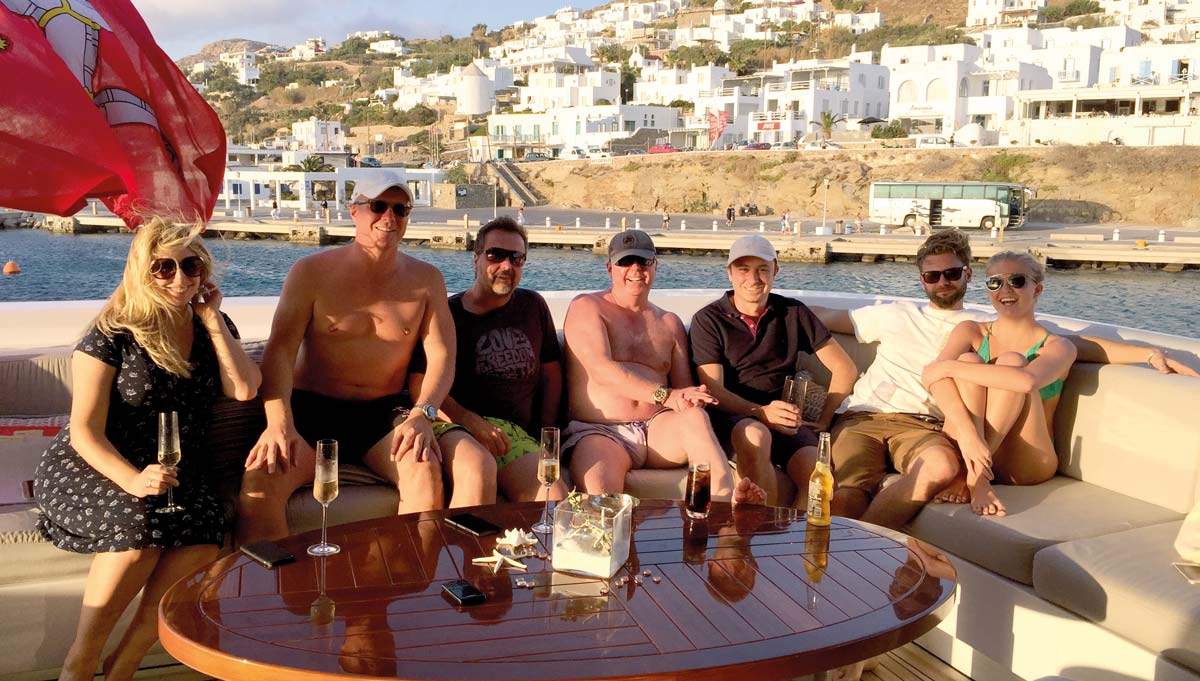
Douglas Barrowman with family
A love of the sea, adventure and technology
Superyachts and yacht ownership are also a way to explore the world around us, and to interact with and grow to understand extraordinarily diverse communities from remote Pacific islands to the Scandinavian Arctic. It’s something that inspired tech entrepreneur Jasper Smith to combine his love of adventure and his love of the sea with an opportunity for owners to give back while indulging their passion.
“I have always had a deep passion for the ocean,” Smith says. “I grew up watching Jacques Cousteau movies and being enthralled at the idea of being challenged by an endeavour.” When he set out to find his own perfect explorer yacht, however, he realised it didn’t yet exist. His answer was to create Arksen. “My aim with Arksen was to create the perfect machines to enable adventure,” he enthuses. “I also wanted to build sustainable boats which considered full life cycles, from material sourcing to recycling.”
That’s not all – Arksen also asks owners of its yachts to sign up to a pledge it calls 10% for the Ocean, where they will donate 10% of their vessel’s time to philanthropic activities. “A lot of people who have the money feel a responsibility to try and make sure that the oceans are well looked after,” Smith explains. “The people that are attracted to Arksen are passionate about the ocean and want to go off on slightly more advanced expeditions and trips. With that audience, there is a tremendous buy-in to the boat being for more than just their own purposes.”
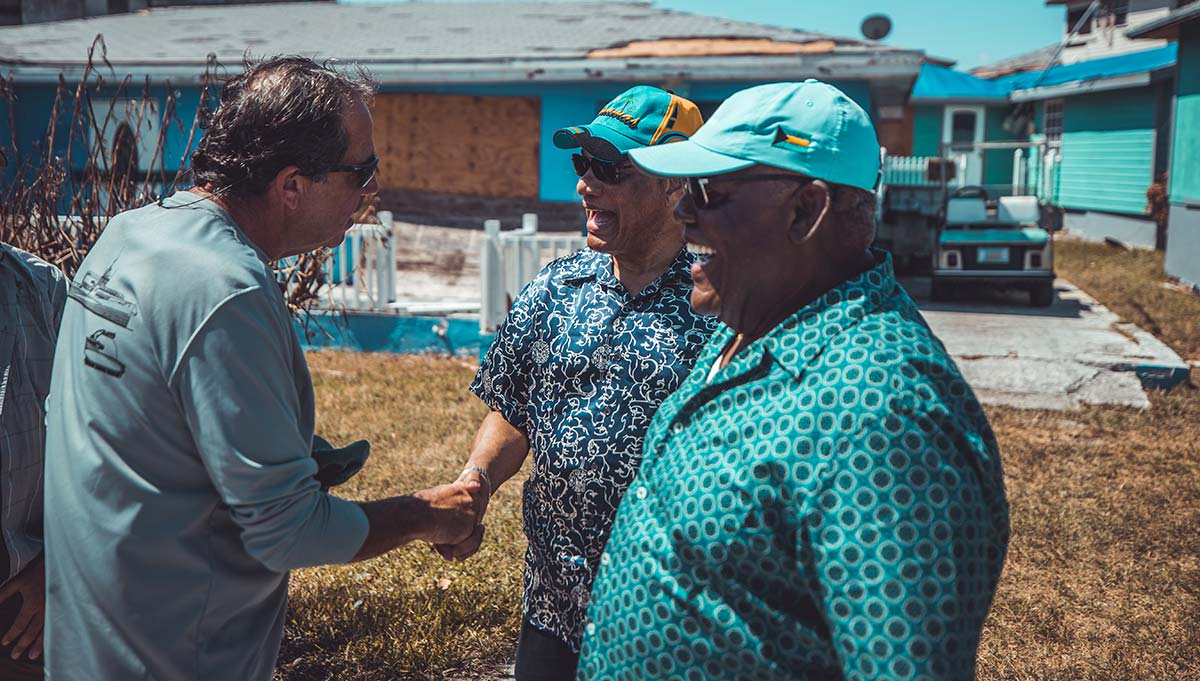
Superyachts as a force for good
It speaks to the heart of the matter, which is that the superyacht industry and yacht owners in particular have a heart – they care about preserving the environment they enjoy, and they care about the communities they interact with who make them feel so welcome when they visit. It’s reflected in the smallest of gestures, such as donating materials and books to local schools, to the largest – helping with last-mile delivery of critical disaster relief. It’s about superyachts giving back.
It’s a positive-impact attitude toward humanity that is quietly typified by hundreds of superyacht owners, who often prefer to do their thing under the radar rather than take false glory for their philanthropic or humanitarian endeavours. For some it’s as straightforward as getting involved in projects with organisations like YachtAid Global . For others, their endeavours become a key reason for yachting.
American superyacht owner Carl Allen is a prime example of these philanthropic yacht owners. After selling his company, and having enjoyed chartering and owning yachts as a family for years, Allen set up Allen Explorations to deliver a full programme of projects, ranging from historical shipwreck searches and environmental research to disaster relief. Indeed, Allen’s support yacht Axis played a vital role in the aftermath of Hurricane Dorian – one of the most powerful storms ever to hit the Bahamas.
“We had to drop everything and help after the hurricane,” says Allen. “ Axis delivered over £700,000 of supplies and made multiple trips to Little Grand island in the Bahamas. We’ve turned it into the epitome of how to organise hurricane relief.” The team helped get the local school back up and running, and organised for a group from Florida Power and Light to help restore power. “The island also lost their water tower,” he adds, “so we delivered four tanks on Axis .”
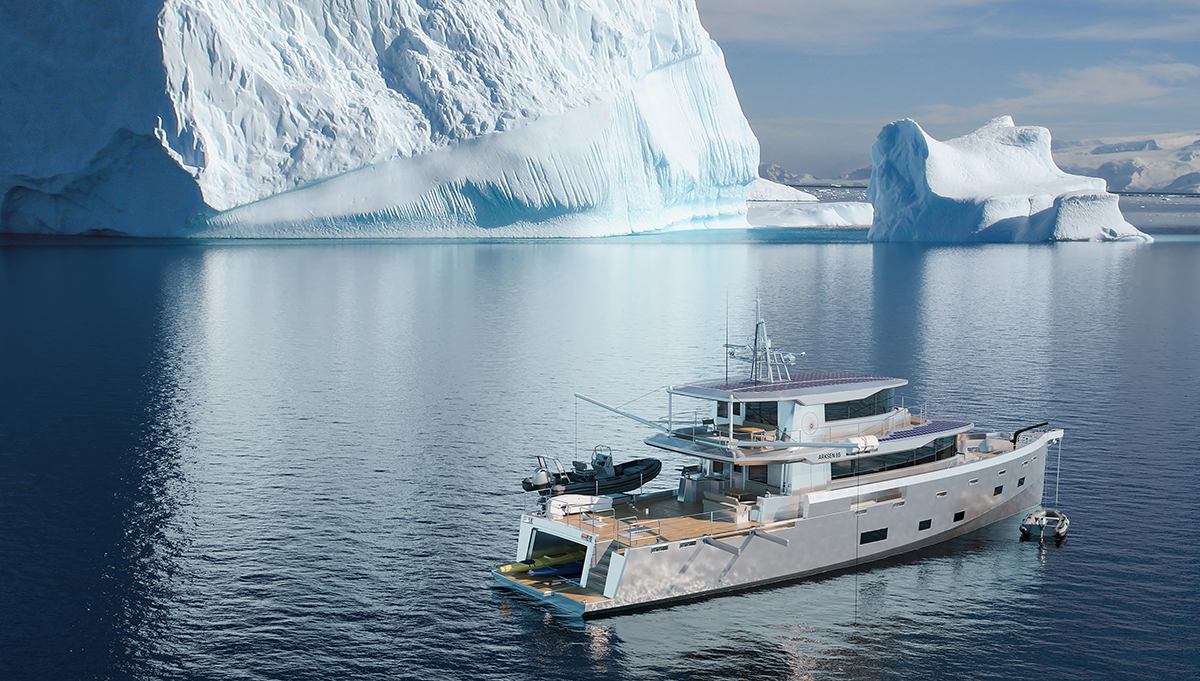
Jasper Smith
Celebrating the good in the superyachting good life
From family time to time spent embracing the global family, superyacht owners have a far greater positive impact than many assume from preconceived ideas about what a superyacht is and the sort of person who owns or charters one. It’s one of the reasons The Superyacht Life Foundation, in association with the Monaco Yacht Show , has unveiled The Honours, which is a way to celebrate the people of our industry rather than the yachts which so often get sole focus. It’s about recognising the extraordinary contributions that people make, the change they inspire, the opportunities they create, and the lives they change.
On 26 September, the eve of the 2023 Monaco Yacht Show, three honourees – nominated by people from across the superyacht industry, and selected from a shortlist by an expert panel of industry judges – will be feted for their work and contribution to superyachting. These are industry professionals and yacht owners who epitomise what superyachting can do. These are people who highlight the good in the superyachting good life.
Yacht owners, impactful journeys
All around the globe, yacht owners are enjoying precious time on their yachts with family and friends, and many are also realising that their yachts can be a force for good and for change, tying in with their philanthropic works and humanitarian endeavours.
“Our yacht is a platform for much of our life,” offers Joe Anderson , co-owner of the Benovia Winery in California with his wife, Mary Dewane. “For instance, we used it at a fundraiser for cystic fibrosis in Baltimore at the 200th anniversary of the Star-Spangled Banner event. The Blue Angels were flying overhead and used Bella Una [the couple’s yacht] as a GPS coordinate and performed flybys, tipping their wings at us. It was quite a thrill. Having a yacht is a way to keep the family intact, enjoy time with friends and have fun.”
You may also like...
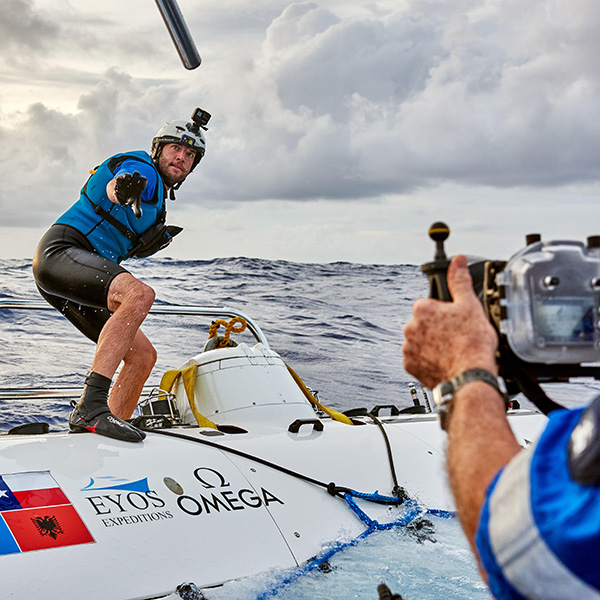
Yachting for daredevils
From underwater exploration to death-defying activities on land, there’s more to chartering than simple cruising.
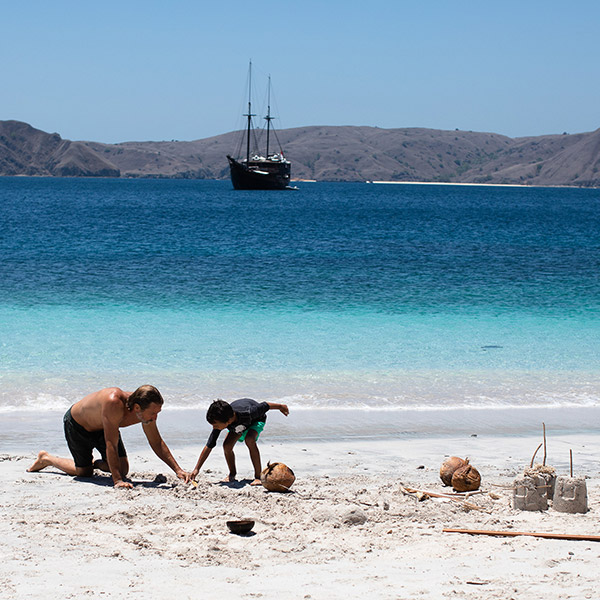
A superyacht with siblings at the helm
When a brother and sister chartered traditional phinisi boat Dunia Baru back in 2017, they never imagined that they would end up owning it.
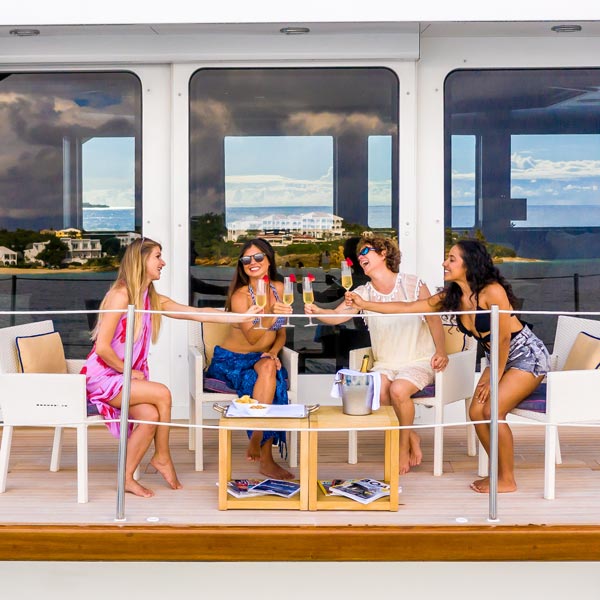
Top five... ways to enjoy a festive family charter
Superyachts might bring to mind sunny beaches and summer holidays, but many families find that charters really come into their own over the festive period.
Do you work in the superyacht industry? Yes No I would like to receive updates from Superyacht Life
Don’t miss out
Sign up to our newsletter and get our latest stories delivered monthly to your inbox.
Watch CBS News
Authorities ID boat operator who fatally struck 15-year-old Ella Adler
By CBS Miami Team
Updated on: May 15, 2024 / 6:46 PM EDT / CBS/CNN
MIAMI - The Florida Fish and Wildlife Conservation Commission identified the boat operator in connection to the death of 15-year-old Ella Adler, who was struck while water skiing in Biscayne Bay on Saturday.
Authorities say Carlos Guillermo Alonso, 78, of Coral Gables, was the boat's operator.
They say he was the only occupant of the vessel on that day, according to the one-page incident report.
FWC24ON0038760_updated-2 by sergio.candido on Scribd
The boat was discovered behind a home in the Hammocks Oaks neighborhood in Coral Gables. Neighbors described the man who lives in the home as a family man and an experienced boater. They said he was devastated by what happened.
Rodney Barreto, the Chairman of the FWC, said this about Ella's death, "It's touched our community in a way."
"When you're 15 years old you don't expect to go out on a boat and not come home."
The new preliminary FWC report says she had been on a boat with 12 other people and was being towed while on a wakeboard.
Records show Alonso owns the house where the vessel was seized.
"The gentleman who was driving the boat who is cooperating with us is Mr. Alonso," said Barreto.
"We have some physical evidence that we have recovered that we have sent to our state lab for testing."
Barreto says officers used witness descriptions to find the boat.
"It was good old-fashioned police work by our officers. We asked them to go up and down the canals from Coconut Grove to South Miami. They went up and down the canals with the physical description they had and recognized the boat."
Batteto said there was no evidence pointing to reckless or drunk driving.
It's not known if the driver will be cited or charged.
"Our job is to gather information and present it to the State Attorney, so they can do their job."
The loss of Ella Adler prompts this warning from Barreto: "Make sure you pay attention to the water and always look around because things can happen on the water and they can happen very quickly."
"We encourage people to use a lot of caution and go to boating safety schools."
"Florida has the most registered boats in the country and Miami-Dade has the most registered boats than any county in Florida."

Ella, the granddaughter of US Ambassador to Belgium Michael M. Adler, was water skiing with friends Saturday near the Nixon Beach sandbar when she fell in the water while being towed and was struck by another boat. The operator of that boat never stopped.
An all out search was then launched to find the boat and driver.
On Wednesday, Florida Fish and Wildlife believed they had found it.
"I am pleased to report that we have a vessel in custody that matches the description given by witnesses," said FWC's George Reynaud. "The boat is in our custody and the owner is cooperating with us."
On Monday morning, hundreds of people attended services for Adler at Temple Beth Sholom in Miami Beach.
On Tuesday, First Lady Dr. Jill Biden stopped by in person to offer her condolences and be with the family.
"We are honored that the First Lady paid a shiva call to our family during this time of immense pain. We are touched by their support and love and we are proud to call the President and First Lady our friends for over 40 years," according to a statement from the family.
Adler was a freshman at Ransom Everglades High School and a ballerina with the Miami City Ballet.
"We are heartbroken," Ransom Everglades posted on Facebook. "Ella Adler '27 shined in our classrooms and on our stages, and she embodied the mission of Ransom Everglades School. We wish peace and comfort to her family."
"We at Miami City Ballet and the Miami City Ballet School are utterly devastated by the heartbreaking news of this tragic accident," said the organization which described Adler as a beloved student and a magnificent dancer who graced their stage. "Our hearts go out to Ella's family, friends, and everyone who had the privilege of knowing and adoring her. As we come together, we will profoundly grieve the loss of Ella, and hold dear the precious memories we were fortunate enough to create with her."
"We extend our deepest condolences to the Adler family at this difficult time," the US Embassy to Belgium said in a statement. "Out of respect for their privacy, we have nothing further."
Anyone who saw the accident or anyone who might have video footage or information about it is urged to call the Wildlife Alert Hotline at 888-404-FWCC (3922) or Miami-Dade Crime Stoppers at 305-471-TIPS (8477).

The CBS Miami team is a group of experienced journalists who bring you the content on CBSMiami.com.
Featured Local Savings
More from cbs news.

Ella Adler's family releases statement; new boating safety initiative planned

Miami man arrested during "vigilante-style" operation to catch child predators

Miami Gardens homes, cars riddled with bullets after shootout

Teen dead after Little Haiti shooting
- Search
- Crime Stories Podcast
- Crime Scene Photos
- Nancy Grace Book
- Crime Library
WATCH 'Crime Stories with Nancy Grace' On Merit Street Media! Click Here For Channel Finder
You are using an outdated browser. Please upgrade your browser to improve your experience.

‘I think he did know’: Maritime Expert Weighs in, Teen Ballerina Ella Mowed Down, Mystery Boat Just Discovered

Florida investigators identified the man operating a yacht that struck and killed a 15-year-old Saturday as Carlos “Bill” Alonso, 78. Still, his attorney said it’s not clear he was the one who hit the girl in Biscayne Bay.
As CrimeOnline previously reported , attorney Lauren Field Krasnoff told reporters on Wednesday that Ella Adler’s death was “an absolutely horrific thing that happened,” adding that Alonso is an “experienced boater.”
An incident report, however, filed by the Florida Fish and Wildlife Commission (FWC) named Alonso as the operator of the 42-foot yacht that struck Adler. The report indicated that Adler and another person were on wakeboards, towed by another 42-foot vessel around a mile offshore when they both fell into the water.
Ella was wearing a lifejacket with her board attached to her foot when the yacht hit her. The yacht operator failed to stop or slow down and continued west from Nixon Beach.
Investigators subsequently searched for the yacht, based on witness descriptions, and found it behind Alonso’s Coral Gables home on Tuesday. The vessel has since been towed in for investigation.
“I think he did know. I think the forensic data of the Alport engines is gonna show when the RPMs jump,” maritime attorney at Lipcon Margulies & Winkleman, Daniel Grammes, said during Wednesday’s “Crime Stories” episode.
“You know, even in a vessel that’s about 30,000 pounds, when you hit a hard object like that, you feel it. So, you know, all this conversation that he may not have heard it–So no matter what, [there] was careless operation on the vessel operator.” “I don’t even think this person came forward. I think the FWC was the one that actually found the vessel and then quote, unquote, ‘we see cooperation,’ which to the extent we don’t know yet, but we will find out.”
It’s not clear at this point if Alonso will face charges.
Adler, a freshman at Ransom Everglades High School, was also an accomplished dancer who performed with the Miami City Ballet.
Check back for updates.
For the latest true crime and justice news, subscribe to the ‘Crime Stories with Nancy Grace’ podcast .
[Featured image: Ella Adler/Handout]
Additional reporting by KC Wildmoon

Hit-and-run boat that killed Florida teen ballerina may have been found. What we know
UPDATE: FWC officers have identified a boat that matches the description. The owner is cooperating.
Authorities may have found the boat that struck and killed a teen girl waterskiing off the coast in South Florida on Saturday, May 11, according to the Florida Fish & Wildlife Conservation Commission .
Officials said Ella Riley Adler, 15, a ballerina with the Miami Ballet, was being towed behind a yacht near the Nixon Beach Sandbar in Biscayne Bay when she fell into the water and was struck by another boat. The boat sped off to the west.
"I am pleased to report that we have a vessel in custody that matches the description given by witnesses and the investigation is ongoing,” said FWC Chairman Rodney Barreto. “As a father and grandfather, my heart is broken for the Adler family. Ella’s death is devastating for her family, friends and the community at large. The FWC and our partner law enforcement agencies will not stop until we have all the answers and the case is solved.”
The vessel is in custody and its owner is cooperating with the investigation, the FWC said in a release.
The boat was described in the initial FWC release as a center console boat with a light blue hull, three or four white outboard engines and possibly blue or dark blue bottom paint.
Investigators said it was unclear if the driver of the boat knew she was there or was hit.
Witnesses or anyone with video footage or information should contact the FWC at 888-404-FWCC or 888-404-3922 or Miami-Dade Crime Stoppers at 305-471-TIPS or 305-471-8477.
A total reward of up to $20,000 — $10,000 from Adler's family and a combined $10,000 from FWC and Miami-Dade Crime Stoppers — is being offered for information that leads to an arrest and successful prosecution of the driver of the hit-and-run boat incident.
Who is Ella Riley Adler of Florida?
Ella Adler was a freshman at Ransom Everglades School in Coconut Grove and a ballerina with the Miami City Ballet. She is the granddaughter of Michael M. Adler, the current U.S. Ambassador to Belgium , according to the Miami Herald .
"We are heartbroken," the school said in a Facebook post Monday morning. "Ella Adler '27 shined in our classrooms and on our stages, and she embodied the mission of Ransom Everglades School. We wish peace and comfort to her family."
Adler appeared in more than 100 performances with the Miami Ballet, including "The Nutcracker," according to her Legacy.com obituary . In school, she performed on the dance team, acted in the school play "Chicago" and was a member of the Ransom Everglades Jewish Students Association.
Miami City Ballet praised Adler in a statement: “Ella Adler was not just a beloved student and a magnificent dancer who graced our stage in George Balanchine’s 'The Nutcracker,' she was an integral part of our family, radiating potential and promise whose kindness, warmth, and infectious joy were known to all.“
"You were taken from us way too soon, and the world has been robbed of all the things you could have achieved," her father, Matthew, wrote in a letter read during a funeral service at Temple Beth Sholom in Miami Beach on Monday, the Miami Herald reported . "But you will always be here with us and your friends and family will carry your energy and spirit forever.”
Adler is survived by her parents Amanda and Matthew, her brother Jaden, and her sister Adalynn, grandparents Judy and Ambassador Michael M. Adler, and Susan and Michael Klaiman, along with several aunts, uncles and cousins.
What happened in the boating death of Ella Adler?
At about 4:30 p.m. Saturday, May 11, (the day before Mother's Day) by the Nixon Beach Sandbar in Biscayne Bay near Miami, the 15-year-old dancer had been waterskiing behind a gray yacht and was being towed when she fell into the water. She was wearing a life jacket and had a board still attached to her feet, an FWC official told NBC6 in Miami .
A witness said the boat did not appear to swerve or slow down when it hit the girl. The yacht towing her immediately spun around back to where she was and began broadcasting distress calls, the witness told NBC6.
Where was Ella Adler killed? Where is Nixon Beach Sandbar in Florida?
The Nixon Beach Sandbar is located in Biscayne Bay, Florida, west of Hurricane Harbor near Miami.
It's a popular destination for recreational boaters and fishing for its white sands and clear shallow waters, and it "turns into a wild party spot every weekend" full of yachts and catamarans, according to the boating site sail.me .
The area was named for former president Richard M. Nixon, who owned a home overlooking the water nearby.
Natalie Neysa Alund, USA TODAY, contributed to this story.
This article originally appeared on The Daytona Beach News-Journal: Hit-and-run boat that killed Florida teen ballerina may have been found. What we know

- Starting a Business
- Growing a Business
- Small Business Guide
- Business News
- Science & Technology
- Money & Finance
- For Subscribers
- Write for Entrepreneur
- Entrepreneur Store
- United States
- Asia Pacific
- Middle East
- South Africa
Copyright © 2024 Entrepreneur Media, LLC All rights reserved. Entrepreneur® and its related marks are registered trademarks of Entrepreneur Media LLC
It Sure Looks Like Mark Zuckerberg Is Taking a Brand New Superyacht Out to Celebrate His 40th Birthday The yachting world has been speculating that the Facebook founder purchased the vessel.
By Madeline Berg and Kelsey Vlamis May 14, 2024
Key Takeaways
- It seems as if Mark Zuckerberg will celebrate his 40th birthday on the megayacht, Launchpad.
- The yachting world has speculated for months that the Meta CEO is the owner of the vessel.
- Now, both the boat and Zuckerberg's private jet have landed in Panama.
This article originally appeared on Business Insider .
All signs point to Mark Zuckerberg celebrating his 40th birthday on what many speculate is his brand-new superyacht Launchpad .
The boating world has been buzzing about Launchpad — a 118-meter yacht built by the Dutch shipyard Feadship — for months, with rumors swirling that her owner is none other than the Meta CEO. But in the yachting world, where privacy is paramount , no party would confirm her owner.
"It is Feadship's standard policy to never divulge any information about our yachts with reference to ownership, costs, or delivery, etc," Feadship, the ship's builder, wrote to Business Insider in March. "Whether it is an 18-meter Feadship from the 1960s or a 118-meter Feadship from the 21st century, we do not share private information."
Representatives for Zuckerberg did not respond to requests for comment from BI.
Now there's even more evidence: The megayacht arrived in Panama on Monday, making her way there from Fort Lauderdale, Florida, where she's predominantly been moored since she made her maiden voyage across the Atlantic in March, according to public ship-tracking data. Wingman, the support superyacht that he is suspected to have purchased with Launchpad, made the journey with her.
Zuckerberg's plane also landed in Panama on Monday, per a private jet tracker, and if his Instagram is any indication, he was on board.
Putting two and two together — along with the many other clues linking Zuckerberg to the yacht — we can surmise that the Meta CEO is likely kicking off his new decade aboard his new toy.
Aerial shots of the yacht seem to show a pool on its main deck and a helipad. Ruben Griffioen/SuperYachtTimes
Little is known about the luxury vessel, which was said to have been built for a sanctioned Russian businessman before it was handed over to the Dutch government, which served as a middleman for the purchase. Her final purchase price is unknown, but it's safe to say a yacht of that size from that shipyard would cost nine figures upfront and six figures a year to maintain.
The few photos of Launchpad available on the industry site SuperYacht Times show there appears to be a helipad and a swimming pool on her main deck.
A vessel of her size can typically sleep dozens of guests and crewmembers and likely has an expansive gym (where Zuckerberg could practice his jiu-jitsu), a spa, a movie room, and a garage to fit plenty of toys like his viral hydrofoil .
Zuckerberg's name was first connected to Launchpad in December when reports swirled that he visited Feadship's shipyard in the Netherlands. By March, yachting blogs like eSysman SuperYachts and Autoevolution suggested he officially snagged the boat at a $300 million price tag. Launchpad also bears the flag of the Marshall Islands, a US territory that is commonplace for American buyers to register their ships.
We will never know for sure whose name is on her title, so unless Zuckerberg confirms he's Launchpad's owner, we will have to wait for an invitation to Zuck's birthday party to confirm.
Want to be an Entrepreneur Leadership Network contributor? Apply now to join.
Editor's Pick Red Arrow
- Lock Want to Start a Simple Business That Helps the Planet? After 'One Night's Worth of Research,' He Started an Eco-Friendly Gig and Now Makes $200,000 a Year
- I've Negotiated High-Pressure, Multi-Million-Dollar Deals for Artists Like Bruno Mars and Enrique Iglesias — Here's the Strategy That Always Helps Me Win
- Lock This Toxic Money Habit Is Becoming More Common — If You've Picked It Up, Your Finances Are at Serious Risk , Expert Warns
- 'This Year Almost Broke Me': Tom Schwartz Reveals 'Scandoval' Almost Shut Down His Restaurant After Losing 80% of His Business
- 'Not What Anybody Signed Up For': A Legal Expert Weighs in on the Labor Rule That Could Destroy Franchising
- Lock Anyone Can Try the Simple Strategy That One Billionaire Investor Used to Make His First Million Dollars Tax-Free
Most Popular Red Arrow
I wish i knew these four things before starting my own business.
Starting a business is hard work to say the least. These are four lessons I wish someone had shared with me before going solo, so I'm here to share them with you.
63 Small Business Ideas to Start in 2024
We put together a list of the best, most profitable small business ideas for entrepreneurs to pursue in 2024.
How To Start a Youtube Channel: Step-by-Step Guide
YouTube can be a valuable way to grow your audience. If you're ready to create content, read more about starting a business YouTube Channel.
Add Some Life to the Office with $60 off This Bluetooth Speaker
This TREBLAB speaker provides 360-degree HD sound and high-powered connectivity.
Organize Your Podcasts and Audio Content with This $40 Plan
Player FM lets you organize and sync podcasts across different platforms in one place.
Need More Confidence? These 10 Bestselling Books Will Help Improve Your Self-Esteem
Self-esteem can be hard to come by and even harder to maintain. To give yourself a boost, try these authors' words of wisdom.
Successfully copied link
9 superyacht crew members share what it's really like working for a billionaire on board
- Superyachts are luxurious, but working on them isn't.
- Insider polled superyacht crew members to find out what it's really like working for a billionaire on board.
- They said their days are spent fulfilling requests and keeping the yacht in top shape — but it really all depends on the superyacht owner.
- Visit Insider's homepage for more stories .

While working on a superyacht sounds glamorous, in reality it can be anything but.
Insider polled superyacht crew members to get an inside look at life on board. When asked what working for a millionaire or billionaire is really like, they agreed on a few things, like long hours.
Many superyacht crew members wake up before dawn to start their day, which typically involves a lot of cleaning and catering to the requests of owners and guests.
Read more: The super rich are hoarding cash — instead bartering yachts, $30 million mansions, and caviar to ride out the pandemic
But while some superyacht owners are demanding, others are less so — it really all depends on their personality. Some crew members said that owners and guests are more like regular people than you'd expect.
Here's what life on board looks like, according to nine superyacht crew members.
Note: Insider was able to verify each crew member's identity, but we refrained from publishing their full names to protect their privacy.
Working on a yacht can be lucrative.
Insider previously reported that deckhands earn an average of $3,083 to $3,574 a month, depending on the boat size. Captains reportedly get paid even more — they earn $7,750 to $19,961 a month on average.
Kate Lardy of the Sun Sentinel reported that a captain in Fort Lauderdale once spent a total of $14,255 on day workers, who are hired temporarily for onboard services, during a two-month period.
But it's also tiring and demanding.
One captain who works on a 120-foot boat alluded to tiring conditions. Working for a billionaire is "demanding," he said, with hours that begin very early — before 6 a.m. — and end very late.
Yacht crew members have to meet high expectations.
One electronic technical officer who works on a 223-foot yacht stressed the pressure of delivering top-notch service while remaining level-headed.
Working on a yacht involves "very, very long days with little rest and expectations to perform at the highest levels of service while not losing your cool under pressure," he said.
They have to work hard to keep yachts spotless.
Guests and owners can be messy and dirty — and it's up to the crew to make sure it doesn't look that way. A mate on a 92-foot yacht said he had to wake up before guests or other crew members to get the yacht's exterior ready for the day.
"They expect it to look like no one has touched it," he said. "So any rain or dew, water spots, bird crap, or salt spray has to be continuously cleaned, not to mention having to constantly wipe stainless [steel] and glass when guests move around the boat. They leave smudges and fingerprints everywhere.
"By the time I start at the top of the boat and move around drying the boat, washing windows, and prepping water toys, depending on where the guests are, it's time to clean behind them."
He said he then has to be available for whatever the day brings, whether guests want to take the tender out or play with water toys, the interior crew needs help with service, or any maintenance issues need to be addressed.
There's a lot of cleaning, smiling, and snacking.
Nic, a chief stewardess, shared her typical daily itinerary, which extends from 6 a.m. to 11 p.m., with a one-hour break for a power nap.
There's constant snacking, as she doesn't always have time to sit and eat, she said. She's also "always thinking and planning ahead for the next meal or excursion," like what guests "need to take with them and what they need upon return," she said.
"Always thinking of ways to make the day special and 'perfect' (as much as possible)," she said.
She added: "Cleaning, cleaning, cleaning, and lots of smiling. Behind the scenes, a lot of running around and working at high speed, throwing stuff into drawers and sorting it out later when you have time, laughing, and keeping crew spirits high. Never-ending laundry."
Work is easier when the owners are away, which is often.
Billionaire owners actually don't spend a lot of time on their multimillion-dollar yachts. Neither do the guests who charter them.
"Owners or guests are typically not on the boat all that much, so most of the time the crew has the boat to themselves," said Michael, a former yacht captain who worked on yachts ranging from 130 to 170 feet.
"Work is pretty easy and consists of general maintenance and keeping the boat in perfect/ready state for when the owner does show up. If you have a good crew it can be very enjoyable. If you do not, it can be very stressful and miserable."
Everything depends on the owner's personality.
Some crew members get lucky working for generous yacht owners, while others get treated like the help.
"It's hard work and long days when they are on board," said Martin, the captain of a 155-foot yacht. "It really depends on the owner. Some have treated me like family, and some have treated me like a servant."
But sometimes it's not the owner who's difficult.
A chef on a 150-foot motor yacht also said that working for a billionaire could be unpredictable, as every boat and owner is different.
But it's not the owner of the yacht who's always difficult to work for.
"Bear in mind that the captain is every bit as much your boss as the owner is, and sometimes the captain is a bigger pain in the ass than the billionaire owner," she said.
Yacht owners are just your everyday people on vacation — with more money.
According to Mark, the captain of a 114-foot yacht, billionaire owners are just like normal vacationers. Kind of.
"They're just people holidaying, but with more money and toys to fill their days," he said.
They can be more down-to-earth than expected, but their spontaneity can be frustrating.
"It's really nice to find out that some of the wealthiest people you'll work for are actually more down-to-earth and normal like any person you'd meet on the street," a stewardess on a 112-foot sailing yacht said. "The saying is 'money screams, wealth whispers.'"
She added: "A typical day involves turning heads, beds, and laundry for guests and crew, which can be a lot if you're a department of one. Food and beverage service three times a day. A lot of plans and schedules change on the fly depending on the owners and their wants and whims, which can be a bit frustrating."
- Main content
TEEN BALLERINA MOWED DOWN BY MYSTERY BOAT JUST DISCOVERED Crime Stories with Nancy Grace
Ella Adler joins a group of twelve for wakeboarding on Biscayne Bay over Mother’s Day weekend. The girls take turns on two wakeboards towed behind the boat. Ella ends up in the water. Still wearing a life vest, she makes it back over to the board and clings to it as she’s towed back to the yacht. While Ella’s still in the water, another boat gets dangerously close and shows no sign of stopping. Moments later, the boat strikes Ella, forcing her underneath. When Ella floats back up to the surface, she’s limp and there’s blood in the water. Ella dies before anyone can get her to shore. The boat that hit Ella never slowed down, despite a legal requirement to stop, call law enforcement, and give aid. Maritime lawyers have contested claims the boat operator may not have realized they hit someone, saying anyone aboard would have felt the hit. A witness saw a fishing boat pass the gray yacht, and heard screams and distress calls over the yacht’s radio. They describe the boat as a light blue center console with dark blue bottom paint and three to four outboard engines. JOINING NANCY TODAY Daniel Grammes - Maritime Lawyer / Attorney at Lipcon Margulies & Winkleman; Insta: @dgram01 Phil Odom – Boating Accident Reconstructionist, Owner of H2O Investigations, and Former Law Enforcement; Facebook: H20 Investigations Dr. Kendall Crowns – Chief Medical Examiner Tarrant County (Ft Worth) and Lecturer: University of Texas Austin and Texas Christian University Medical School Dr. Michelle DuPre – Former Forensic Pathologist, Medical Examiner and Detective: Lexington County Sheriff’s Department, Author: “Homicide Investigation Field Guide” & “Investigating Child Abuse Field Guide;” Forensic Consultant Sydney Sumner - CrimeOnline Investigative Reporter See omnystudio.com/listener for privacy information.
- Episode Website
- More Episodes
- 2024 iHeartMedia, Inc. © Any use of this intellectual property for text and data mining or computational analysis including as training material for artificial intelligence systems is strictly prohibited without express written consent from iHeartMedia
Top Podcasts In True Crime
Man gets realistic picture of his boat painted on a fence intended to hide it
A California man who was ordered to keep his boat out of sight has had the last laugh by commissioning an artist to paint a realistic image of it on the fence that obscures it.
Local government officials told Etienne Constable, of Seaside, California, in July that he had to build a 6-foot fence to hide the boat from view of his neighbors.
In a light-hearted jibe at officialdom, Constable decided to follow the directive, which said nothing about how the fence should be decorated, and asked local artist Hanif Panni to create a mural that makes it look as if the fence isn't there.
"I’m not a rule-breaker, but I like to make a political statement as necessary, as well as a humorous statement and a creative statement," he told NBC affiliate KSBW of Monterey Bay .
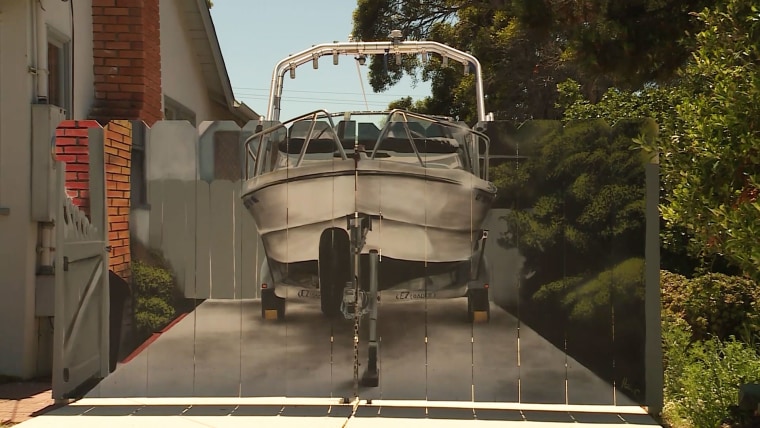
He is yet to have had any contact from the city about the mural — but he said he considers it to be covered by the right to freedom of expression as enshrined in the First Amendment.
"The reaction is extremely more than we ever expected, and we’re both just tickled about it," Constable said, referring to the stir the image has made on social media, where it has been shared many times.
Panni, who paints images across the Central Coast area, told KSBW: "I’m a big proponent of public art in spaces. It engages people in ways that reaching out and having conversations doesn’t sometimes."
And Panni added that since the Seaside boat mural has gone viral, other boat owners have approached him to see whether he can do the same for them.
Patrick Smith is a London-based editor and reporter for NBC News Digital.
- Search Please fill out this field.
- Manage Your Subscription
- Give a Gift Subscription
- Newsletters
- Sweepstakes
Boat That Struck and Killed 15-Year-Old Fla. Ballerina Found, Authorities Say
"Ella’s death is devastating for her family, friends, and the community at large," said Florida FWC Chairman Rodney Barreto
CBS Miami/ Youtube
Authorities are one step closer to learning more about 15-year-old Ella Adler's death .
Ella died on Saturday, May 11, after being hit by a boat while waterskiing near Nixon Beach in Key Biscayne, Fla., the Florida Fish and Wildlife Conservation Commission (FWC) said in a previous statement .
The FWS noted that the "center console boat with a light blue hull" and "multiple white outboard motors" had fled the scene and asked for any witnesses to come forward.
On Tuesday, the FWC announced in a news release and on Instagram that a vessel "that fits the description" is now in their custody.
According to WTVJ , the boat was "docked behind a house in the Hammock Oaks neighborhood in southwest Miami-Dade." Although the boat owner's identity has not been released, the FWC said that "the owner of the vessel is cooperating with the investigation."
The FWC added that "while significant progress has been made, this investigation remains open; the public’s assistance is still needed."
FWC Chairman Rodney Barreto called the teenage ballerina's death a "great loss this Mother’s Day weekend."
Levitt-Weinstein Memorial Chapels & Cemeteries
"As Chairman of the Florida Fish and Wildlife Conservation Commission, I would like to thank all our officers and those from various law enforcement agencies who have worked and continue to work tirelessly on this investigation. The FWC and its officers have called in additional resources from other parts of the state and have worked around the clock to find the vessel involved in the accident," Barreto's news release statement read.
The chairman confirmed that the investigation is ongoing and said, "As a father and grandfather, my heart is broken for the Adler family."
"Ella’s death is devastating for her family, friends, and the community at large. The FWC and our partner law enforcement agencies will not stop until we have all the answers and the case is solved," his statement continued.
In her obituary , Ella is remembered as someone who "worked hard at everything she did."
"Ella shone on stage as a ballerina in the Nutcracker, appearing in over 100 performances with the Miami City Ballet at the Adrienne Arsht Center. Her magnetism radiated on the stage, where she belonged and thrived," the obituary reads, adding that Ella also performed with the Ransom Everglades dance team.
Want to keep up with the latest crime coverage? Sign up for PEOPLE's free True Crime newsletter for breaking crime news, ongoing trial coverage and details of intriguing unsolved cases.
A memorial service for Ella was held on Monday at Temple Beth Sholom in Miami Beach, Fla., per KMIZ .
Related Articles
StarTribune
Dispute over ramadan hours leaves owner of turkish cafe facing drop in business.
A dispute that started during Ramadan between a northeast Minneapolis restaurant owner and the city has led to allegations of police and city harassment, along with a drop in his business.
Michael Mokhalad, owner of Mrs. Dessert & Kumpir, had sought a temporary license to extend his hours during Ramadan this spring. Such licenses became available in 2015 after the city approved an ordinance allowing businesses to apply to stay open late during the Islamic holy month.
Mokhalad said that although he never heard back from the city about his license application, he stayed open after hours. Now he said he's looking for a new location after receiving four citations from the city — enforcement that began, according to city records, after a fight and shooting near his business in late March.
He said business has fallen even more since Ramadan, a drop he attributes to a "bad reputation" in the community over his issues with the city. One Google review of the business said his restaurant "has become a hotspot for late night crime, which they refuse to do anything about."
"Sales have dropped; it's really, really bad," Mokhalad said. "People are saying my business is bringing the crime and violence."
After receiving the four citations for staying open after permitted hours, he said he's looking for a new location for his restaurant. He said he's lost two employees who cited concerns about the police presence there.
"Police are harassing me and the rest of the customers and the employees," Mokhalad said.
Minneapolis police officials declined to comment for this story.
Mrs. Dessert & Kumpir opened in late 2023 in the Holland neighborhood, bringing Middle Eastern pastries and street food to the Twin Cities. It was Mokhalad's first venture into business ownership and his introduction to the northeast Minneapolis community.
Mokhalad said he inquired about a temporary license to extend his hours beyond 10 p.m. during Ramadan, which started on March 10. In the holy month, Mokhalad said, there's always a rush after sunset when Muslims are allowed to break their fast. Many show up later at night after going first to pray, he said.
A city inspector sent Mokhalad application materials to extend his hours. He said he signed and turned them in. He then began staying open until about 3 a.m. Business picked up, he said.
"I was selling almost 300 pieces of each flavor of the cake," he said.
The conflict between Mokhalad and the city began after an early morning shooting on March 24 in the same block as his restaurant. After a fight involving a large group of people, two men ages 21 and 17 went to Hennepin Healthcare with noncritical gunshot wounds. No one has been arrested, and it's unclear where exactly the shooting occurred.
In an email from a public records request filed by the Sahan Journal, Amy Duncan Lingo, business licensing manager for Minneapolis, said she was notified about the shooting the next day. She said Mokhalad's restaurant lacked a permit or license to operate later.
Because the incident involved a fight and shooting, the city issued Mokhalad a $200 citation, Lingo said. "It was made clear that they were not to be open without approval," she said.
On March 27, police returned to the restaurant for a follow-up inspection and found it again operating past 10 p.m. The city issued a second citation for $400.
"Mr. Mokhalad told me of their struggles with slow business in the morning, which I understood, but I stated again that his opening late unauthorized ... created a dangerous environment for the neighborhood," Lingo wrote.
She said she would not process his application until an inspector approved Mokhalad's security plan.
Another incident on April 2 "showed not only that they were still open beyond approved hours but that them being open was creating an unstable and dangerous situation," Lingo wrote.
An $800 citation was then issued.
When the city forced him to close at 10 p.m., Mokhalad said, his sales dropped by 85%. "Every single night, more than 20 missed calls from people," he said.
He said police increased their presence outside his business around closing time during Ramadan. He said they sometimes would park outside with lights on and tell customers showing up after 10 p.m. that the business was closed.
One of the citations obtained by the Sahan Journal said Mokhalad was notified that his business must "close, and customers vacate the premises by 10 p.m." He said he turned off his "open" sign at that time but continued to serve people who had come in before closing. "I have to sell them," Mokhalad said.
A city spokeswoman said Mokhalad's application to temporarily extend his hours was filed "after the initial citations." The restaurant owner said he submitted it before his first citation, though to the wrong precinct office.
He received another citation, he said, for setting up a table and chairs outside. He said he was told he could apply for a permit for outdoor seating.
"I didn't apply yet because I know what the result is going to be," Mokhalad said.
About the partnership
This story comes to you from Sahan Journal , a nonprofit newsroom dedicated to covering Minnesota's immigrants and communities of color. Sign up for a free newsletter to receive Sahan's stories in your inbox.
Minnesota Democrats announce deal on minimum pay for Uber and Lyft drivers
- In surprise, Minnesota GOP backs Royce White to run against Klobuchar
- It's not funny: The disheartening state of creative and cultural nonprofits in Minnesota
- Emptying state institutions was supposed to help fix mental health care. What happened?
- Review: Rob Schneider shows Mystic Lake crowd there's humor outside the liberal bubble
- Game 7 is a chance to make Wolves history — and for one player to rewrite his

Twin Cities native Dolores Rosedale, glamorous '50s TV model and actress, dies at 95

Minnesota Legislature races toward deadline with bonding, rideshare bills in question

South metro program sweeps a tight set of adapted softball finals

Minnesota music legend Spider John Koerner dies at 85

- Game 7 is a chance to make Wolves history — and for one player to rewrite his 8:11pm
- In surprise, Minnesota GOP backs Royce White to run against Klobuchar 5:21pm
- Minneapolis traffic deaths still well above pre-pandemic levels • Minneapolis
- Dispute over Ramadan hours leaves owner of Turkish cafe facing drop in business • Minneapolis
- Is Minneapolis' bird-safe glass ordinance saving avian lives? • Minneapolis
- 3 people fatally shot in different Minneapolis neighborhoods within 17 hours; 2 of the victims ID'd • Minneapolis
- Cyclist discovers 'shocking' mess on greenway. Minneapolis mounted police explain. • Minneapolis
© 2024 StarTribune. All rights reserved.

The global authority in superyachting
- NEWSLETTERS
- Yachts Home
- The Superyacht Directory
- Yacht Reports
- Brokerage News
- The largest yachts in the world
- The Register
- Yacht Advice
- Yacht Design
- 12m to 24m yachts
- Monaco Yacht Show
- Builder Directory
- Designer Directory
- Interior Design Directory
- Naval Architect Directory
- Yachts for sale home
- Motor yachts
- Sailing yachts
- Explorer yachts
- Classic yachts
- Sale Broker Directory
- Charter Home
- Yachts for Charter
- Charter Destinations
- Charter Broker Directory
- Destinations Home
- Mediterranean
- South Pacific
- Rest of the World
- Boat Life Home
- Owners' Experiences
- Interiors Suppliers
- Owners' Club
- Captains' Club
- BOAT Showcase
- Boat Presents
- Events Home
- World Superyacht Awards
- Superyacht Design Festival
- Design and Innovation Awards
- Young Designer of the Year Award
- Artistry and Craft Awards
- Explorer Yachts Summit
- Ocean Talks
- The Ocean Awards
- BOAT Connect
- Between the bays
- Golf Invitational
- Boat Pro Home
- Superyacht Insight
- Global Order Book
- Premium Content
- Product Features
- Testimonials
- Pricing Plan
- Tenders & Equipment

Tequila tycoon Todd Chaffee's journey from kayak to 63m Benetti
The owner of 63-metre Artisan tells Risa Merl how he moved from canoes to superyachts – and created a fine tequila marque along the way
Before owning his 63-metre Benetti Artisan , Todd Chaffee’s previous vessels were canoes, duck hunting boats and kayaks. The jump in size from canoe to superyacht is not the typical progression in yacht ownership, but it’s a fitting metaphor for Chaffee’s astonishing career trajectory.
He swiftly ascended the corporate ladder as the youngest-ever EVP of Visa International before moving on to become one of the world’s top venture capitalists (he is ranked at number six on Forbes’ Midas List of founder VCs, and regularly features in The New York Times ’ annual list of Top 100 Venture Capitalists). Now, between focusing on charitable work and the launch of a multi-award-winning tequila brand, Cierto Tequila, Chaffee spends time on board Artisan with his wife, family and friends.
Currently residing in California (with homes in Lake Tahoe, Aspen and Cabo, Mexico), Chaffee hails from the upper midwestern state of Minnesota, the oldest of four boys in an athletic family. “We all played [American] football, hockey and baseball so essentially our family was a built-in sports team,” Chaffee says. Minnesota might not have an ocean nearby, but it borders Lake Superior, the largest of the Great Lakes, and is known as the “land of 10,000 lakes” – there are actually 11,842 dotted around the state. It was on these lakes that Chaffee was first exposed to boats and life on the water.
His earliest boating memory is of canoeing through the Boundary Waters, a chain of lakes in northeast Minnesota leading up to the Canadian border. Chaffee’s parents were outdoorsy and would take the family up to these pristine waterways every summer. “It’s an untouched series of lakes. You take your canoe up there, fill it with supplies, and disappear for a few weeks,” Chaffee says. “That’s where I started my kinship with being on the water, when I was only three or four years old.”
The first boats Chaffee owned in Minnesota were canoes and camouflage-painted duck hunting boats. “When I moved to California, I started kayaking, then I jumped all the way to superyachts!” he says with a laugh. He’s also been a long-time reader of BOAT International magazine, he tells me. “I’ve been into your magazine longer than I’ve had Artisan ,” he says. “When I get the little brown package [with the magazine inside] my eyes light up and I tell my wife, ‘You know what’s in here? Happiness.’”
Chaffee came to superyacht ownership with a solid idea of what he wanted in a boat, forged during a decade of chartering experience. One of his early dates with his now-wife, Kat, was on a charter yacht named Le Rêve in the BVIs to visit Richard Branson on Necker Island. You know, your usual first-date fare. “I became hooked on yachting,” says Chaffee. “It was just the two of us, and we had a fantastic time. Ever since then, we chartered yachts every winter in the Caribbean and every summer in the Mediterranean.”
They tried a range of boats over the years – even a sailing yacht one summer – but usually ended up with Benettis. After many enjoyable years of chartering, Chaffee decided to buy a boat in 2021. He sought out a yacht with good performance that was large enough to host friends and family – he has three older children and an eight-year-old daughter — and it had to be aesthetically pleasing.
“I searched high and low – I swear to God, I saw every boat at the Monaco Yacht Show but I couldn’t find anything that was exciting to me,” he says. “Then a friend said there might be a 63-metre Benetti available that wasn’t on the market yet. I flew over to Palma to see it and said, ‘This is it.’ It took me less than an hour to decide I was going to buy it.” What struck Chaffee about Artisan (formerly Metis ) was her blend of an elegant exterior with a spacious interior and powerful performance. “It’s hard to find that combination,” he says. “Often when a yacht is sleek and sexy, they are narrow and confined.”
Designed by Giorgio Cassetta , this Benetti is defined by its vertical bow and long foredeck. “It slices through the water beautifully. We will be moving sometimes and not even feel it – I’ll wake up in a new place and didn’t even notice we were underway.”
Chaffee has built six homes, so he has an eye for design and was particularly impressed by Benetti’s craftsmanship. “As you know in the yachting world, the Northern European brands have a tendency to be known as higher quality and the Italian boats have better style,” he says. “But the Benettis are solid and the artisanship is incredible. And Giorgio did an exceptional job with the exterior design.” Chaffee named the yacht Artisan as a tip of the hat to the team who created her and a gesture of gratitude for their hard work.
He and Kat fine-tuned the existing Bannenberg & Rowell interiors with furnishings and artworks to make it their own, and reimagined some of the ways the spaces on board are used, such as the forward deck. “The front helideck is used as a seating area on Artisan ,” he says. It is outfitted with chaise lounges and is a popular place to hang out. Another favourite area for Chaffee is the forward fly deck, set just above the bridge deck, which has an enclosed gym and a forward “love nest” – a lofty area with a round outdoor sofa. “The views are spectacular and it’s a fantastic place to work,” he says. “My family and friends know that if I’m not around, I’m up top.”
Though Chaffee keeps an eye on work while on board, he plays plenty, too. He and his guests are always active, whether exercising, doing yoga or playing with Artisan ’s water toys and tenders. He’s recently added a brand new Fjord 44 chase boat to the fleet. Chaffee loves nothing more than a tender ride back to the boat in the evening, when the sun has set and the light of the yachts at anchor twinkle like waterborne stars. “Seeing the yachts in the harbour all lit up at night from the tender is magical,” he says, likening it to stepping out on the playa at Burning Man at night and seeing all the art installations and bicycles aglow in the open desert.
The ethos on board Artisan is enjoying life and spending quality time together, and Chaffee relishes getting to share the experience of yachting with his loved ones. This past winter Kat’s whole family joined them for a week on board, then the next week he brought his whole family. “We had so many guests, I had to rent a second yacht and another chase boat!” says Chaffee. “I didn’t realise I’d get so much satisfaction seeing friends and family laugh and smile and enjoy their time on board. Our guests often tell us that their trip on Artisan was the best week of their life. I thought I was buying a boat for vacation and freedom – I didn’t realise it would also be so rewarding to share my love of yachting with others. That’s the hidden pleasure of this whole experience – it’s a way to bring joy to people. The secret of living is giving.”
It’s a joy that he wants to share with those beyond his inner circle. Artisan was used privately the first two years Chaffee owned her, but she has recently joined the charter fleet. “It’s crazy to have a superyacht of such high calibre sit empty with no one enjoying her,” he says.
And, through his NobleLight Foundation, Chaffee is in the process of planning a charitable program that would bring exceptionally talented underprivileged children on board to spend a week enjoying Artisan as guests. NobleLight supports a long list of nonprofits and social entrepreneurs. Much of the foundation’s work is connected to environmental causes, and Chaffee envisions the visits on board Artisan as having an environmental connection as well. “I donate to a lot of environmental organisations; it’s especially important when I have a plane and a superyacht, I have to atone for my carbon footprint,” he says.
Fostering successful teams, it seems, is built into Chaffee’s DNA. He joined the venture capital company IVP as managing director and general partner in March 2000, building it into one of the most successful VC firms in Silicon Valley. IVP invested in big-hitters such as Twitter, Netflix and Coinbase. “We have some of the best and brightest people in the venture industry, and have a great culture of teamwork,” says Chaffee. He also founded the luxury adventure travel company Grand Expeditions.
Whether it’s entrepreneurship, philanthropy, tequila or yachting, Chaffee’s passion and spirit shines through. “I’m not really a person who values material things, but when it comes to yachting, that’s the one place where I’m wowed by the art, design and science behind superyachts,” Chaffee says. “I love the yachting community, too. Everyone is so friendly. I think it’s something about having to take your shoes off. You can’t get too serious when you’re barefoot!” Chaffee might finally own a superyacht, but at the end of the day, this Minnesota kid is as laid-back as they come.
Artisan is available for charter with Burgess.
First published in the August 2023 issue of BOAT International. Get this magazine sent straight to your door, or subscribe and never miss an issue.
ENTREPRENEURIAL SPIRIT
Success in the VC world has allowed Todd Chaffee to step into his next chapter of philanthropy and also launch a luxury tequila. “When I researched the spirits industry, I discovered that most tequilas are full of fake colours, artificial sugars and glycerin,” he says.
This inspired Chaffee to create a 100 per cent natural, additive-free tequila that was smooth and easy to drink. He and his team met with the top distilleries in Mexico, eventually collaborating with Enrique Fonseca and his nephew Sergio Mendoza, two of the most respected master distillers in the industry. “Enrique and Sergio have deep, multi-generational knowledge of the agave plant. This gives them a great advantage when crafting a luxury tequila, and we are honoured to partner with them,” says Chaffee.
Thus, Cierto Tequila was born – cierto meaning “true” in Spanish, referring to the pure nature of the tequila. Initially, the tequila was a private passion of Chaffee’s. Then his team started entering Cierto in spirit competitions. It’s now racked up more than 700 international awards, making it the most awarded tequila in history. Cierto launched in the US in February, and several of the top bars and restaurants in St Barths already stock it for their high-end clientele.
More about this yacht
Similar yachts for sale, more stories, most popular, from our partners, sponsored listings.
Web publishers brace for carnage as Google adds AI answers
The tech giant is rolling out AI-generated answers that displace links to human-written websites, threatening millions of creators
Kimber Matherne’s thriving food blog draws millions of visitors each month searching for last-minute dinner ideas.
But the mother of three says decisions made at Google, more than 2,000 miles from her home in the Florida panhandle, are threatening her business. About 40 percent of visits to her blog, Easy Family Recipes , come through the search engine, which has for more than two decades served as the clearinghouse of the internet, sending users to hundreds of millions of websites each day.

Podcast episode
As the tech giant gears up for Google I/O, its annual developer conference, this week, creators like Matherne are worried about the expanding reach of its new search tool that incorporates artificial intelligence. The product, dubbed “Search Generative Experience,” or SGE, directly answers queries with complex, multi-paragraph replies that push links to other websites further down the page, where they’re less likely to be seen.
The shift stands to shake the very foundations of the web.
The rollout threatens the survival of the millions of creators and publishers who rely on the service for traffic. Some experts argue the addition of AI will boost the tech giant’s already tight grip on the internet, ultimately ushering in a system where information is provided by just a handful of large companies.
“Their goal is to make it as easy as possible for people to find the information they want,” Matherne said. “But if you cut out the people who are the lifeblood of creating that information — that have the real human connection to it — then that’s a disservice to the world.”
GET CAUGHT UP

70 years later, 1 in 3 Black people say integration didn’t help Black students

Journalists sue Chicago Tribune owner alleging pay discrimination

Abbott grants Daniel Perry pardon in murder of Black Lives Matter protester

NFL disavows Harrison Butker’s comments, cites commitment to inclusion

6 Airbnb red flags to spot before you make a booking mistake
Google calls its AI answers “overviews” but they often just paraphrase directly from websites. One search for how to fix a leaky toilet provided an AI answer with several tips, including tightening tank bolts. At the bottom of the answer, Google linked to The Spruce, a home improvement and gardening website owned by web publisher Dotdash Meredith, which also owns Investopedia and Travel + Leisure. Google’s AI tips lifted a phrase from The Spruce’s article word-for-word.
A spokesperson for Dotdash Meredith declined to comment.
The links Google provides are often half-covered, requiring a user to click to expand the box to see them all. It’s unclear which of the claims made by the AI come from which link.
Tech research firm Gartner predicts traffic to the web from search engines will fall 25 percent by 2026. Ross Hudgens, CEO of search engine optimization consultancy Siege Media, said he estimates at least a 10 to 20 percent hit, and more for some publishers. “Some people are going to just get bludgeoned,” he said.
Raptive, which provides digital media, audience and advertising services to about 5,000 websites, including Easy Family Recipes, estimates changes to search could result in about $2 billion in losses to creators — with some websites losing up to two-thirds of their traffic. Raptive arrived at these figures by analyzing thousands of keywords that feed into its network, and conducting a side-by-side comparison of traditional Google search and the pilot version of Google SGE.
Michael Sanchez, the co-founder and CEO of Raptive, says that the changes coming to Google could “deliver tremendous damage” to the internet as we know it. “What was already not a level playing field … could tip its way to where the open internet starts to become in danger of surviving for the long term,” he said.
When Google’s chief executive Sundar Pichai announced the broader rollout during an earnings call last month, he said the company is making the change in a “measured” way, while “also prioritizing traffic to websites and merchants.” Company executives have long argued that Google needs a healthy web to give people a reason to use its service, and doesn’t want to hurt publishers. A Google spokesperson declined to comment further.
“I think we got to see an incredible blossoming of the internet, we got to see something that was really open and freewheeling and wild and very exciting for the whole world,” said Selena Deckelmann, the chief product and technology officer for Wikimedia, the foundation that oversees Wikipedia.
“Now, we’re just in this moment where I think that the profits are driving people in a direction that I’m not sure makes a ton of sense,” Deckelmann said. “This is a moment to take stock of that and say, ‘What is the internet we actually want?’”
People who rely on the web to make a living are worried.
Jake Boly, a strength coach based in Austin, has spent three years building up his website of workout shoe reviews. But last year, his traffic from Google dropped 96 percent. Google still seems to find value in his work, citing his page on AI-generated answers about shoes. The problem is, people read Google’s summary and don’t visit his site anymore, Boly said.
“My content is good enough to scrape and summarize,” he said. “But it’s not good enough to show in your normal search results, which is how I make money and stay afloat.”
Google first said it would begin experimenting with generative AI in search last year, several months after OpenAI released ChatGPT. At the time, tech pundits speculated that AI chatbots could replace Google search as the place to find information. Satya Nadella, the CEO of Google’s biggest competitor, Microsoft, added an AI chatbot to his company’s search engine and in February 2023 goaded Google to “ come out and show that they can dance .”
The search giant started dancing. Though it had invented much of the AI technology enabling chatbots and had used it to power tools like Google Translate, it started putting generative AI tech into its other products. Google Docs, YouTube’s video-editing tools and the company’s voice assistant all got AI upgrades.
But search is Google’s most important product, accounting for about 57 percent of its $80 billion in revenue in the first quarter of this year. Over the years, search ads have been the cash cow Google needed to build its other businesses, like YouTube and cloud storage, and to stay competitive by buying up other companies .
Google has largely avoided AI answers for the moneymaking searches that host ads, said Andy Taylor, vice president of research at internet marketing firm Tinuiti.
When it does show an AI answer on “commercial” searches, it shows up below the row of advertisements. That could force websites to buy ads just to maintain their position at the top of search results.
Google has been testing the AI answers publicly for the past year, showing them to a small percentage of its billions of users as it tries to improve the technology.
Still, it routinely makes mistakes. A review by The Washington Post published in April found that Google’s AI answers were long-winded, sometimes misunderstood the question and made up fake answers.
The bar for success is high. While OpenAI’s ChatGPT is a novel product, consumers have spent years with Google and expect search results to be fast and accurate. The rush into generative AI might also run up against legal problems. The underlying tech behind OpenAI, Google, Meta and Microsoft’s AI was trained on millions of news articles, blog posts, e-books, recipes, social media comments and Wikipedia pages that were scraped from the internet without paying or asking permission of their original authors.
OpenAI and Microsoft have faced a string of lawsuits over alleged theft of copyrighted works .
“If journalists did that to each other, we’d call that plagiarism,” said Frank Pine, the executive editor of MediaNews Group, which publishes dozens of newspapers around the United States, including the Denver Post, San Jose Mercury News and the Boston Herald. Several of the company’s papers sued OpenAI and Microsoft in April, alleging the companies used its news articles to train their AI.
If news organizations let tech companies, including Google, use their content to make AI summaries without payment or permission, it would be “calamitous” for the journalism industry, Pine said. The change could have an even bigger effect on newspapers than the loss of their classifieds businesses in the mid-2000s or Meta’s more recent pivot away from promoting news to its users, he said.
The move to AI answers, and the centralization of the web into a few portals isn’t slowing down. OpenAI has signed deals with web publishers — including Dotdash Meredith — to show their content prominently in its chatbot.
Matherne, of Easy Family Recipes, says she’s bracing for the changes by investing in social media channels and email newsletters.
“The internet’s kind of a scary place right now,” Matherne said. “You don’t know what to expect.”
A previous version of this story said MediaNews Group sued OpenAI and Microsoft. In fact, it was several of the company's newspapers that sued the tech companies. This story has been corrected.


IMAGES
COMMENTS
The 38.74m/127'1" gulet yacht 'That's Life' was built by Custom. Guest Accommodation. That's Life has been designed to comfortably accommodate up to 10 guests in 5 suites comprising one VIP cabin. She is also capable of carrying up to 7 crew onboard to ensure a relaxed luxury yacht experience. Onboard Comfort & Entertainment
Short Answer. The ownership of superyachts is generally private, so the exact answer to who owns which superyacht is not always publicly available. However, there are some notable superyacht owners that are known. For example, Larry Ellison, the co-founder of Oracle, owns the Rising Sun, which is the 11th largest superyacht in the world.
All yacht owners are 'rich', but some are richer than others. For example, when a wealthy person is able to purchase a US$ 10 million yacht. His net worth is probably between US$ 50 million and US$ 100 million. Similar, when you are able to purchase a US$ 50 million yacht. Your net worth will probably be a few hundred million dollar.
THAT'S LIFE was built by Custom and delivered to her owner in 2009. THAT'S LIFE can accommodate 10 guests in 5 cabins consisting of a primary suite with a king size bed and en-suite bathroom facilities, 2 cabins with a king size bed and en-suite bathroom facilities, a cabin with a single bed and a pullman bed and en-suite bathroom facilities ...
Kusch Yachts. LE GRAND BLEU (371 feet) owned by Russian oil billionaire Evgeny Shvidler *currently in St Barths. Superyacht ANNA owned by Russian billionaire Dmitry Rybolovlev. Feadship. ANNA (360 ...
In fact, Hagewood's newly relaunched Galaxy is the ultra-luxe- Burning Man -inspired, superyacht spaceship the young, first-time superyacht owner always knew he wanted. Superyacht Galaxy. Jack ...
Every month, superyacht owners reveal where they are in the world and share their future plans. This month, BOAT speaks to an owner about a new-build project with zero regrets and an owner who is lucky enough to do once-in-a-lifetime cruising twice... Owner of Asteria. Length: 49m Year: 1970 Location: Norway
As younger, more adventurous owners like tech billionaires have joined the superyacht market, the design of yachts and the toys they carry have changed markedly. New types of vessels have been created to meet this desire for off-the-beaten-track cruising, from support yachts to water toys to the massive growth in explorer yachts.
The sailing yacht, which is hard to miss thanks to her massive size and unique design, was host to Bezos and his fiancée Lauren Sanchez's famous friends. The couple held an engagement party on ...
The yachting life style awes even the wealthy. "Boats are the last place that I think you can get away with it," an owner said. Photo Illustration by Javier Jaén; Source photograph from ...
The Florida owner of a boat matching the description of one that struck and killed a 15-year-old Florida ballerina on Saturday has been identified in an incident report obtained by Fox News Digital.
Herb Chambers' 263-foot-long award winning yacht Excellence underway in the Med. Guillaume Plisson for Abeking & Rasmussen. Superyacht owners are often, um, how should we say, pretty aloof.And I ...
Last refitted in 2018, the yacht started out life at 256 feet, with an additional 16 feet added to accommodate the owner's choice of an aft deck dining table.
Adler was wakeboarding behind a 42-foot 2017 Hanse Fjord yacht at the same time as an unidentified female on a wake surfboard. The two people being towed fell into the water at different times and ...
That's not all - Arksen also asks owners of its yachts to sign up to a pledge it calls 10% for the Ocean, where they will donate 10% of their vessel's time to philanthropic activities. ... "Our yacht is a platform for much of our life," offers Joe Anderson, co-owner of the Benovia Winery in California with his wife, Mary Dewane ...
The new preliminary FWC report says she had been on a boat with 12 other people and was being towed while on a wakeboard. Records show Alonso owns the house where the vessel was seized.
The yacht operator failed to stop or slow down and continued west from Nixon Beach. Investigators subsequently searched for the yacht, based on witness descriptions, and found it behind Alonso's Coral Gables home on Tuesday. ... "You know, even in a vessel that's about 30,000 pounds, when you hit a hard object like that, you feel it. So ...
Officials said Ella Riley Adler, 15, a ballerina with the Miami Ballet, was being towed behind a yacht near the Nixon Beach Sandbar in Biscayne Bay when she fell into the water and was struck by ...
The boating world has been buzzing about Launchpad — a 118-meter yacht built by the Dutch shipyard Feadship — for months, with rumors swirling that her owner is none other than the Meta CEO.
Some crew members get lucky working for generous yacht owners, while others get treated like the help. "It's hard work and long days when they are on board," said Martin, the captain of a 155-foot ...
Every month, superyacht owners reveal where they are in the world and share their future plans. This month, the 32-metre Windship and Trident-built sailing yacht Elton prepares for her 2024 European tour, while a championship-winning sailor states his preference for an expedition motor yacht.... Andy Scott, owner of Elton. Length: 31.7m Year: 1992 Location: Portsmouth
The girls take turns on two wakeboards towed behind the boat. Ella ends up in the water. Still wearing a life vest, she makes it back over to the board and clings to it as she's towed back to the yacht. While Ella's still in the water, another boat gets dangerously close and shows no sign of stopping.
On board explorer La Datcha with owner Oleg Tinkov. The Russian self-made billionaire has always wanted to explore: first beyond the Iron Curtain and now even further on his 77m SeaXplorer, as he tells Caroline White. "It's the same tired song and dance every time: Portofino, Porto Cervo and Monaco. The same boring triangle," says Oleg ...
Etienne Constable was told to build a 6-foot fence to hide the boat from view of his neighbors — but he got an image of the boat painted on the fence.
Francesca Webster sat down with Jim Glidewell, serial yacht owner and lover of Alaska, to find out more about his life with yachts. I joined Jim Glidewell aboard his 58-metre Trinity superyacht Unbridled at Rybovich Marina during the Palm Beach International Boat Show this March. It was the second time I had the pleasure of meeting Jim, having first interviewed him under the same circumstances ...
The Florida Fish and Wildlife Conservation Commission announced that a vessel fitting the description of the boat that struck and killed 15-year-old Ella Adler on Saturday, May 11, has been found.
A dispute that started during Ramadan between a northeast Minneapolis restaurant owner and the city has led to allegations of police and city harassment, along with a drop in his business. Michael ...
Investigators have located a boat that may have struck and killed the 15-year-old granddaughter of a US diplomat near Key Biscayne, Florida, on Saturday, authorities said.
The owner of 63-metre Artisan tells Risa Merl how he moved from canoes to superyachts - and created a fine tequila marque along the way. Before owning his 63-metre Benetti Artisan, Todd Chaffee's previous vessels were canoes, duck hunting boats and kayaks.The jump in size from canoe to superyacht is not the typical progression in yacht ownership, but it's a fitting metaphor for Chaffee ...
As the tech giant gears up for Google I/O, its annual developer conference, this week, creators like Matherne are worried about the expanding reach of its new search tool that incorporates ...